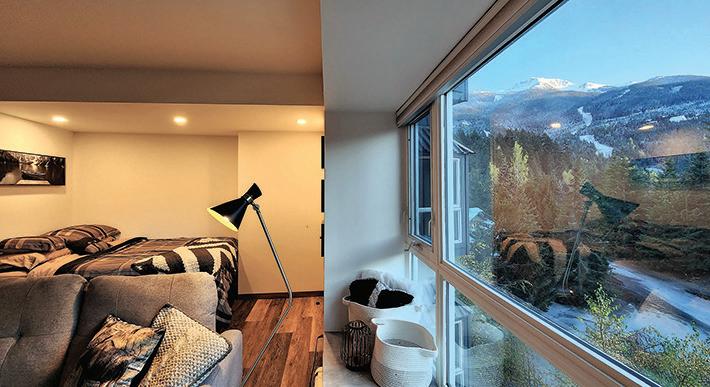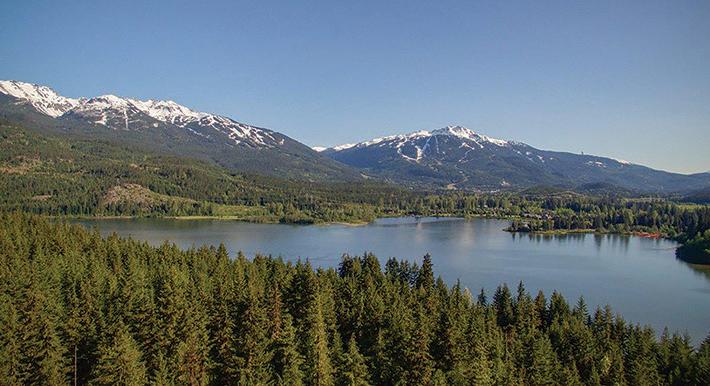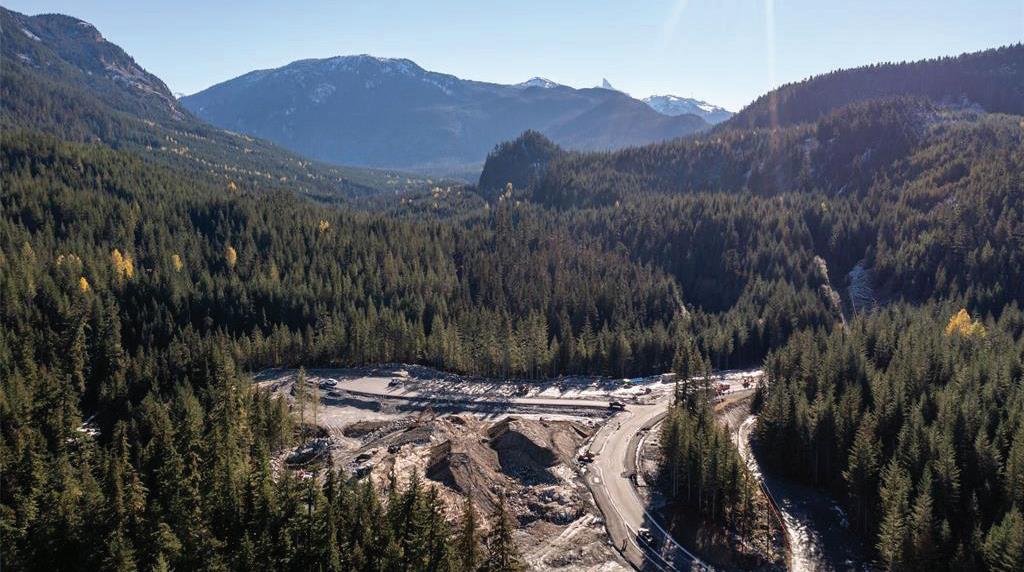


































































EVER? Whistler’s housing crisis in 2022: clothes optional, corporal punishment from old men mandatory.

The federal government is investing $10 million in wildfire mitigation efforts in Whistler, to be used for fuel treatments in 12 high-risk areas.

Spilling the beans on the local caffeine scene. - By Rosa O’Reilly COVER If I’m honest, I’ve never been able to stomach a cup of coffee without Baileys. - By Jon Parris // @jon.parris.art



































































Founding Publishers KATHY & BOB BARNETT
Publisher SARAH STROTHER - sstrother@wplpmedia.com
Editor BRADEN DUPUIS - bdupuis@piquenewsmagazine.com

Sales Manager SUSAN HUTCHINSON - shutchinson@wplpmedia.com

Production Manager AMIR SHAHRESTANI - ashahrestani@wplpmedia.com
Art Director JON PARRIS - jparris@wplpmedia.com
TESSA SWEENEY - tsweeney@wplpmedia.com
GEORGIA BUTLER - gbutler@wplpmedia.com
Digital/Sales Coordinator AMELA DIZDARIC - traffic@wplpmedia.com
Production production@piquenewsmagazine.com
Features Editor BRANDON BARRETT - bbarrett@piquenewsmagazine.com
Arts Editor ALYSSA NOEL - arts@piquenewsmagazine.com
Social Media Editor MEGAN LALONDE - mlalonde@piquenewsmagazine.com
BRANDON BARRETT - bbarrett@piquenewsmagazine.com
MEGAN LALONDE - mlalonde@piquenewsmagazine.com
ALYSSA NOEL arts@piquenewsmagazine.com
ROBERT WISLA - rwisla@piquenewsmagazine.com
DAVID SONG - dsong@piquenewsmagazine.com
Classifieds and Reception mail@piquenewsmagazine.com
Office and Accounts Manager HEIDI RODE hrode@wplpmedia.com
Contributors G.D. MAXWELL, GLENDA BARTOSH, FEET BANKS, LESLIE ANTHONY, ANDREW MITCHELL, ALISON TAYLOR, VINCE SHULEY, LISA

Subscriptions: $76.70/yr. within Canada, $136.60/yr. courier within Canada. $605.80/ yr. courier to USA. GST included. GST Reg. #R139517908. Canadian Publications Mail Product Sales Agreement #40016549.
















BEAR WITH ME HERE, as I prepare to drop the hot take to end all hot takes.
*stretches broadly, cracks fingers* Seriously. Get your sunscreen ready because this bad boy is coming straight off the surface of the sun.
*pours a fresh cup of coffee, cues up The Rolling Stones*
Last chance to clear the area. I can’t be held responsible for the hotness of the take that is to follow.

*clears throat*
Still with me? OK, but you’ve been warned—here it is: We should be nicer to Vail Resorts.
BY BRADEN DUPUIS*ducks a shoe, but is instantly tarred and feathered*
I told you it was a hot take. But bravery demands sacrifice.
*is hit by an errant brick*
I jest, of course (at least partly… the last time I wrote that we should be nicer to each other I got a 3 a.m. voicemail telling me I am the stupidest person alive, and literally a high-ranking official with the Nazi Party— ah the joys of working for a newspaper).
But as opening day 2022 inches nearer, I have to ask: is the rhetoric around Vail Resorts becoming too much?
The negativity has been building for some time now—dare I say, since Vail Resorts bought Whistler Blackcomb in 2016—but it reached a fever pitch last year, and not just in Tiny Town.
The ski resort behemoth took its lumps early and often in 2021-22, in nearly every market it operates in, as the negative headlines piled up one on top of the other.
Labour shortages, a lack of affordable housing for workers, overcrowding on ski runs, attempts to unionize, petitions calling for change… the breadth of the bad coverage really is impressive when taken together.
(Credit where it’s due: Vail Resorts responded to its year of bad headlines by jacking up the minimum wage at all its
properties, and re-committing itself to developing housing for its employees. Not the proverbial silver bullet, but an excellent step in the right direction.)
Here in Whistler, aside from the usual gripes about day-to-day operations, guests mostly complained about sluggish refunds and the mountain operator’s COVID guidelines (both for and against).
Then the big one hit: the announcement earlier this month that Whistler Blackcomb’s (WB) Creekside Gondola/Big Red Express replacement project won’t be ready for opening day on Nov. 24.
*Cue torches, pitchforks*
Let’s get the obvious out of the way.
No matter how WB and Vail Resorts try to spin it, the Creekside delay is nothing short of a customer service disaster, and reading the company’s stated contingency plans sparked a surprisingly wide range of emotions.



First, disbelief: “They’re going to bus people from Creekside to Whistler Village? And those people will get to skip to the front of the line?”
Followed by a sardonic sense of schadenfreude: “Aren’t the people already waiting going to be pissed?”
Vail Resorts executives and their healthy bonuses. I get it. But I also don’t believe genuine human error, or forces beyond our control warrant personal attacks and the outright vitriol people toss around on social media like it’s their God-given right.
And yet, something about our modern society demands absolute perfection, at least in those things that affect us directly.
Highway construction slowing down your commute? What a bunch of absolute morons! Don’t they know they could do this work at night? Gah!
A wait for a table at your favourite restaurant? Don’t they know who I think I am?
A mistake in the newspaper? This indignity will not stand! Where did you get your journalism degree? An outhouse?
Supply chain impacts delay a key infrastructure project? Idiots! Any potatobrained mush-mouth could have foreseen this problem! If only I was in charge of mountain operations, we wouldn’t be in this mess.
Alas.
And so we arrive at one of the simplest, and yet most easily misinterpreted facets of human nature—that we are all, in fact, human, and humans sometimes make mistakes.
be desired, and its insistence on top-down uniformity has watered down the guest experience in Whistler. No, as consumers we should not give the company a free pass.
But as we level our valid criticisms we must remember that the people who operate our hometown mountains are locals, no matter who signs their paycheque.

And so I suppose my sympathy lies less with the company itself than with the humans behind the desks and counters, and operating the lifts—the ones who will no doubt bear the brunt of the impatient public’s rage should things go sour this winter.
I’m sure if Vail Resorts had things its way, everything about the mountains would operate smoothly and effortlessly; everyone would get their chosen powder laps without delay; nobody would get hungover from their overly enthusiastic après sessions and burgers and poutine would fall from the sky every Friday afternoon.


Sadly, here in the real world, perfection is a pipedream. Mistakes do happen, après hangovers are painfully real, and the only thing falling from the sky is boring-ass water.
As an added bonus, the take-home advice here is all-weather and multi-
And finally, empathy: “Wow, this is going to create a tough winter for a whole lot of people.”
I have to say, I was not expecting that last one. And yet, as the furor over the Creekside announcement subsided, there it was: Sympathy for the Devil (or in this case, a multi-billion-dollar ski resort conglomerate).

I must be getting soft in my old age.
I know, I know. Someone out there is playing the world’s smallest violin for all the
For some reason, many like to conveniently ignore this fact, choosing instead to hand wave the vast interconnected network of real-world variables that can (and do) lay waste to the best of best laid plans.
Anger is just easier, and, let’s be honest, more cathartic.
Yes, Vail Resorts is a multi-billiondollar American company homogenizing hometown mountains the world over. Yes, its customer service leaves much to
purpose, not solely confined to your feelings about the mountain and its operations.
It could be about your lunch order, or the driver in front of you forgetting to signal.
With very, very few exceptions, nobody screws up on purpose. Telling them how terrible and stupid they are, in the meanest of possible terms, is not helpful for anyone.
Put another way, let’s all just be nicer to each other, yeah?
*is crushed by a piano* ■
Cheer on the world’s top oyster shuckers as they battle for glory against the clock, experience the innovative and exciting Bloody Caesar competition entries from B.C.’s best bartenders, and celebrate the return of Whistler’s ultimate party.





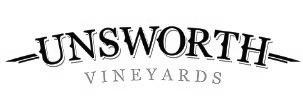
































































Net proceeds from this fundraising event will be donated to Myeloma Canada. Myeloma is the second most common blood cancer.





The following text was delivered by Anne Townley at Whistler’s Service of Remembrance on Nov. 11, 2022. Words by G.D. Maxwell.
Once again we gather together on this November morning to remember. Members of Whistler’s community, visitors, guests, colour guard, uniformed service personnel, we all gather regardless of the weather to honour those who have fought, those who have lived, those who have died, those who struggled at home to keep some semblance of country and community moving forward.
Most of all we gather to remember. Remember the wars, the police actions, the breakdown of diplomacy... the carnage. For if we don’t remember, if we turn our attention away from the world’s bloody history, we devalue the efforts of all those who came and fought and died before.
And forgetting is a small step towards finding ourselves engaged in a new conflagration those who come after us will have to gather to remember. Remember because we forgot. Because someone forgot. Because failing to remember cast a pall over the future.
This year, unlike many years past when we’ve gathered, that pall looms larger than it has since the end of the Second World War. In the absence of remembering the horrors of the past, the ceaseless human conflict between imperialism and nationalism, the desire to build empires,
to regain lost glory, to devalue human life, is threatening to expand from a land far from us and pull the world into the black hole of conflict once again.
This day, Remembrance Day, originally called Armistice Day, was created in Canada in 1931 to mark the end of the hostilities of the First World War, the war to end all wars.
The geo-political causes of World War I were many. The decline of the Ottoman Empire and the growing strength of Austria-Hungary, the nationalist movements in the Balkans, the alignment of what would come to be known as the Central Powers and the Allied Powers laid the foundation.
But it was the act of one man, Gavrilo Princip, on July 28, 1914, that lit the fuse. A Serbian nationalist chaffing under Austro-Hungarian rule, he shot and killed Archduke Franz Ferdinand, heir to the Austro-Hungarian Empire, in Sarajevo, Bosnia. The world was at war.
It was a war like none the world had ever seen. Advances in military technologies and the horrors of trench warfare led to the deaths of some 20 million military personnel and civilians and the wounding of that many more.


And so, we remember.
The war to end all wars, with all its horrors, didn’t. Instead it laid the ground work for World
War II. Which was, in turn, sparked by one man who rallied a country to hold its collective head up... and be great again.
The Treaty of Versailles ended World War I. It also punished Germany for that country’s role in the war. It extracted heavy financial reparations, demilitarized the country, prohibited German unification with Austria and stripped the country of many territories and overseas colonies. The ensuing Great Depression resulted in the Weimar Republic falling to Adolph Hitler and the Nazi Party in 1933.
Six years later, Hitler invaded Poland, Great Britain and France declared war on Germany.
A year later, Benito Mussolini threw Italy’s support behind Germany, attacking the French Alps and later Greece.
A year after that, Isoroku Yamamoto, the commander-in-chief of the combined fleet of the Imperial Japanese Navy, executed the plan he’d created to attack the United States pacific fleet at Pearl Harbor, plunging the U.S. and Japan into the war, a war most of the rest of the world was eventually drawn into, a war that became the most deadly war in history.
Hitler in Germany. Mussolini in Italy. Yamamoto in Japan. Three men; three proximate acts; 70 to 80 million people erased from the Earth by the time peace was finally declared.
We remember... Again!
Veterans of World War II still number in the hundreds of thousands. Each and every one remembers as though it was yesterday. So do those who lived through the experience at home. Some are here today. We remember with them.
There are no veterans of the war currently being fought in Ukraine, only active duty personnel. Another war started by one man. One man who has chosen to not remember.
As we gather here today to honour and remember, we are less safe than we were a year ago. For the first time in decades one man cavalierly tosses out the idea of deploying nuclear weapons and the world shudders in horror. One man dismisses the allegations that the forces he’s unleashed have committed crimes against humanity. One man threatens to draw the rest of the world into bloody conflict yet again.
But in too many other places around the world, one man—always a man—holds the reins of power and has the potential to use that power in a way future gatherings will have to look back on and remember. Whether to expand influence, claim or reclaim disputed territories, avenge perceived wrongs, pit one deity against another or simply subjugate another people, the dogs of war are tethered on slim leashes and strain to be let slip.
But today, we remember. We honour those who have served during and those who have lived through war. We hope those who still serve will serve only in peace.
My dad Roy was born in 1915 in Grahamdale, Manitoba. One of nine kids, dad was the son of German immigrant farmers. It was a poor and hard life. The local excitement was to go down to the rail station on Saturday nights and see who got off the train.
Dad grew up as a farmer, baseball player and a forest warden with little formal schooling and lots of hard, hard work.
At the outbreak of the Second World War, dad (along with his two brothers) immediately signed up, and soon shipped out as a member of the 12th Field Company—Royal Canadian Engineers. From 1939 to 1945, dad furthered his skillset training and travelling up and down the U.K., moving up in rank (and back again), finally being deployed to Italy, France, the Netherlands and Germany. Dad’s bravery and actions under fire were recognized, and he was “Mentioned in Dispatches” eventually achieving the rank of
Sergeant, which stuck.
He met his life’s love, Eileen Rose Peters, during the war, in London where they married... needing his officer’s written permission to do so. Mom often would say that dad was the “smartestdressed soldier” she ever saw.
Their wedding pictures were filled with brave and far too young soldiers and beautiful friends of the bride. Things were so tight in war-time England that mom’s wedding dress had already been worn by two previous brides.
Injured during the war, dad spent time at Shaughnessy Hospital in Vancouver, built the family home in North Vancouver and worked for Canada Post. He passed far too young at just 49 years of age.
I think of him often, and honour him and his memory every year on Remembrance Day at the Whistler cenotaph.
Brian Buchholz // Tapley’s Farm, Whistler









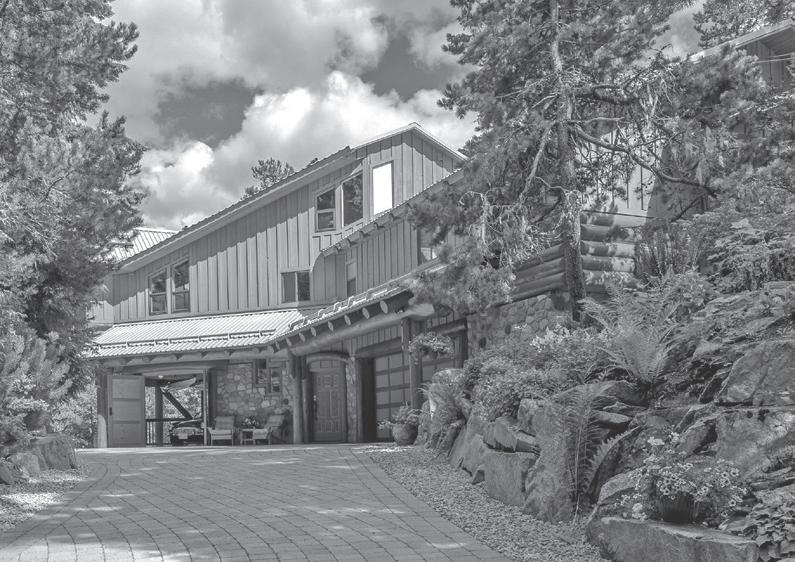

On behalf of the Whistler Remembrance Day Committee, I wanted to take a moment to thank those who made this year’s ceremony a success. Many thanks to the Whistler Singers and the Children’s Chorus, those who read poems or readings, the military, first responders and veterans who marched in the parade, Whistler Fire Rescue Service for logistical assistance, Arts Whistler and West Electric for their audio-visual efforts, the bugler, the piper, those responsible for the cannonade, Blackcomb Helicopters for the fly past and the Rotary clubs for the refreshments. And finally, thanks again to the veterans who sacrificed so much so that we could have the freedom we enjoy today.
Steve LeClair // Chair – Whistler Remembrance Day CommitteeWe all get it, Leslie Anthony espouses conceited, left-of-center liberal ideology in his bumbling columns (Pique, Nov. 3: “Range Rover: The boiling frog”). Fine by me—it’s still a free country (unless people of his ilk try to change that).

Can you perhaps tell him that he can stop kicking now, as the horse is already dead?
Geoff Bate // Whistler nPique Newsmagazine had another solid showing at the Canadian Community Newspaper Awards in 2020 and 2021.
Winners for both years were announced on Nov. 14.
In all, Pique took first in four different categories in the national competition, which celebrates the best in community publishing from across the country. Newspapers of similar circulation size compete against each other and are judged by a panel of industry experts.
Pique’s honours included: 1st place, 2020—Best All-Round Newspaper (6,50017,499 circulation); 1st place, 2020—Best
Front Page (6,500-17,499 circulation); 1st place, Best Feature Story, 2020—“Every Face Tells A Story” by Brandon Barrett; 1st place, Business Writing, 2020—“Growing Pride: Lil’wat Nation poised to capture economic potential” by Braden Dupuis; and 2nd place, Historical Writing, 2021—“The Legend of Frank Gott” by Alyssa Noel.
Pique’s sister paper the Squamish Chief, meanwhile, secured two 2nd-place finishes (for Best Feature Story and Best Editorial Page) and two 3rd-place finishes (Best All-Round Newspaper and Best Front Page) in 2020, as well as a 3rd place finish in 2021 for Best Front Page. n
Write to us! Letters to the editor must contain the writer’s name, address and a daytime telephone number. Maximum length is 450 words. Pique Newsmagazine reserves the right to edit, condense or refrain from publishing any contribution. Letters reflect the opinion of the writer and not that of Pique Newsmagazine GOT GOOD VIBES TO SHARE? Send them to goodnews@piquenewsmagazine.com
Nov 24th: Permanent jewellery by Lazy Maisie


























Enjoy a glass of wine with Helen from Lazy Maisie She will be making permanent jewellery for you! Registered event
Dec 1st: Games night with Rio Macdonald


Guest artisan, Rio MacDonald the young entrepreneur that created two best selling games Lifts and Runs and Lifts and Trails
Dec 8th: Riedel wine night

Taste the difference! Try out a Riedel wine glasses compared to a regular one Sample some delicious BC wines while you’re at it! Wine provided! Register Event
Dec 15th: Engraving and Calligraphy night
Dec 22nd: Fuse and Sip night
AS THE BRAND-NEW sports reporter at Pique Newsmagazine, I had never been to Whistler before my arrival on Friday, Nov. 4. I knew beforehand that it’s a gorgeous resort town nestled among majestic, snow-capped peaks. I knew it was a major hub for the 2010 Winter Olympics, the event that caused me to become the passionate sports fan I am
BY DAVID SONGtoday. I knew that it was more than just a dot on the map, with roughly 14,000 residents in addition to the waves of tourists that come through every year.
I did not know beforehand that the closest IMAX movie theatre is about two hours away, and I was admittedly troubled to learn of this fact.
Before you locals judge me too harshly, please allow me to introduce myself. I’m 26 years of age (going on 27) and I have no siblings. I was born in New York City, which gives me an American passport to go with my Canadian one. After bouncing around several major cities (Beijing, Shenzhen, Hong Kong and Toronto, in no specific order), my parents and I moved to Calgary when I was seven years old. The only other

place I’ve lived is Indianapolis, Ind., where I completed my master’s degree in sports journalism earlier this May.
In other words, Whistler is the only place with a population under a million people that I’ve ever called home.
Some of you might be asking yourselves: what exactly is a city boy like myself doing in this neck of the woods? Surely, he must love fresh powder, or was raised astride a mountain bike. False and false. The extent of my skiing experience is one singular lesson back when I was in Grade 6. I own a very average road bike that I haven’t used in years (and did not bring with me).

So why Whistler then?
Well, despite my lack of skiing and biking aptitude (I am far better at watching sports than playing them), I love the outdoors in my own way. Give me a picturesque view of mountains, trees or water on a nice, sunny day and I could stare at it for hours. Getting into nature and breathing fresh air, be it in a city park or the grandeur of Banff, has always been good for my mental health, so the privilege of living in such a beautiful place is not lost on me.
Secondly, as I mentioned, I love sports. Hockey, football, basketball, swimming, track and field, baseball, mixed martial arts, freestyle skiing and snowboarding… I have a genuine interest in all of these and more.
When time allows, I go to great lengths to check out sports of the non-mainstream variety (for instance, buying a VPN last year so I could watch an NCAA Division I women’s volleyball championship that wasn’t available in Canada).
Most of all, I love the Olympic Games. Ever since 2010, I have watched Olympics coverage (summer and winter) like a man
future career, so when this opportunity arose at Pique, I was excited to take it. My work here will allow me to get to know this community, telling meaningful, grassroots stories that larger publications might overlook. I’m obviously very new here and I don’t claim to have much existing knowledge about what makes Whistler tick, but I look forward to learning.
Of course, it has been an adjustment going from Calgary, Alta., to Whistler, B.C. This town has what you need to get by, but I haven’t found all the good spots yet. I already plan to drive down to Vancouver next month to watch Avatar: The Way of Water on the biggest possible screen, and I might just do the same thing with Black Panther: Wakanda Forever. (Yes, I’m aware that this is not a frugal idea, so we’ll see).
obsessed. I’m talking six to nine hours a day for two weeks straight every two years, and in that time, I do nothing else for fun. Such calculated fanaticism has bred in me an appreciation for sports like skiing, snowboarding and bobsleigh, and this town has plenty of that going on.
Furthermore, I’m a people person, and that fact was obvious from the moment I could talk. I’ve always hoped to incorporate my desire to connect with others into my
Here’s what I’ve already begun to appreciate about Whistler: The natural beauty, obviously. The lively, non-stop sporting scene. The fact that there are so many people from different places (I’ve already met folks from Quebec, the U.K., Australia, Poland, Hong Kong and the Czech Republic just by visiting local stores and restaurants). Most of all, the sense that there are friendly and close-knit communities here, willing to welcome you if you put in the effort to find them.
I’m sure parking will get harder to find once the mountain opens, though. n
Ever since 2010, I have watched Olympics coverage (summer and winter) like a man obsessed.
WITH LOCAL BUSINESSES AND THE WHA STRIVING TO HOUSE WORKERS, IS IT REALLY WORSE THAN EVER? IT DEPENDS WHO YOU ASK
BY MEGAN LALONDEWHISTLER LOCAL Briony Valentine jumped at the chance to secure a windowless space north of the village that she describes as “basically a cupboard” ahead of the upcoming winter season, agreeing to pay just shy of $800 per month for the privilege.
Though she’s “pretty sure” the lack of a window is a fire hazard, “I don’t want to give it up because I found it through a friend from work and it’s cheaper than $1,000 and includes all bills,” she told Pique.
Fire hazard notwithstanding, Valentine’s current living situation represents one of the more positive outcomes people seeking housing in Whistler could hope to find this fall.
Among other prospects? Sharing a sofa bed with a stranger for $1,600 per month (you’ll be splitting the one-bedroom apartment with another couple). A longterm lease with negotiable rent, if you’re open-minded to a clothing-optional home life. Sharing a studio apartment for $2,000 each. Scammers promising a too-cheapto-be-true private room, so long as you e-Transfer a deposit in advance. (Hot tip: never send money to a landlord without seeing the property in-person first.) Space in a sauna for the low monthly price of $1,000. Trading accommodation for sexual favours. A repurposed garage that comfortably fits one couple for $4,500.
Those are just a few of the head-spinning scenarios shared with Pique in recent days by new and longtime Whistlerites, some of whom have turned to tactics like printed flyers, door-knocking and even dating apps as they search for a place to lay their head this ski season.

“People in this town are prepared to call anywhere home as long as it’s secure for [six] months,” Valentine explained.
Still, there are limits. Zane Phillips reached his earlier this week, when he stopped by a local fast-food joint for “a housing meeting” that he said left him “shocked” and “disgusted.” He has his own long-term accommodation locked in, but dropped by to scope out the opportunity for a friend who is not yet in town.
At the meeting, he found 10 other prospective tenants who had been invited to verbally duke it out for one of six remaining spots in a two-month lease. The price? $11,000 a month in total split amongst seven tenants, plus half a month’s security deposit, all expected to be paid upfront.
“All people were visibly stressed, freaking out about the situation,” he said.
“The scene I saw—quite honestly, it was grim,” Phillips said. “I sat down and said to these people, ‘Look, at the end of the day, there’s so many mountains in Western Canada you can go to, and you can come back here in summer.’” The meeting’s host “basically turned around and said ‘Look, there’s 11 of you, we need six of you, go ahead and figure it out.’”
The bizarre encounter represents “the harsh reality” Whistler employees are confronting, said Phillips. “I got up and said ‘nah, one less person.’ My friend’s been here before, we can figure something out.”
He added, “Literally, I was faced with girls that were crying, bawling their eyes out, just not knowing what’s going to happen and just in despair. It’s horrible to see. It’s horrible that this is happening.”
Scott Lynch also attended that meeting. Like Phillips, he ultimately took himself out of the running for one of the six spots— aside from being deterred by the nearly $4,000 in upfront fees, Lynch has a hostel bed secured for the next month and felt confident waiting for another offer. Unlike Phillips, he stuck around a little longer to see it through.
“I ended up pulling names out of a hat,”
Lynch said with a laugh.
The meeting wasn’t even the most unconventional housing offer Lynch has received since landing in the Sea to Sky about a month ago.
Earlier this month, a young man responded to his “seeking housing” post on Craigslist. This young man told Lynch he had a spare room available in the home he shared with his grandfather for a morethan-reasonable price, but there were a few caveats: the grandfather’s house rules included no drinking, no smoking, no overnight guests, and a mandatory curfew. In addition to a three-month period of “preventative discipline,” breaking those rules could result in having electronics “taken away,” being grounded, and even “corporal punishment.” (Yes, Lynch has screenshots to back this up.)
“There were a couple of times where I was like, ‘Well, maybe if I just go in there for a month, like December, and then find something else … but then you kind of snap yourself out of it, and say, ‘no way, this is mad,’” Lynch said, adding, “I’m nearly 30 years old, I’m not having a curfew ... and as far as corporal punishment, he’s definitely not laying a hand on me.”
Raise the issue of Whistler’s current housing woes, and a longtime local or two will usually seize the opportunity to harken back to their own experiences living in a closet in the ’90s, assuring newcomers “it’s been like this for decades.”
Not to burst their housing bubble, but Whistler’s accommodation crunch indeed appears to be getting worse by several measures
In Sept. 2010, the back section of Pique featured six full pages of classified listings advertising long-term accommodation in Whistler. In last week’s Pique , there was a single listing advertising a two-bedroom in Pemberton.
In terms of online ads, there were 240 Craigslist results for rental accommodation in Whistler, Squamish and Pemberton in Sept. 2016, according to archived notes from Pique editor Braden Dupuis. (A handful came from people seeking rentals.) Among those, a one-bedroom suite in Whistler Village for $2,200, a two-bedroom in Creekside for $2,700, a three bedroom Creeside duplex for $3,800 and several one-bedroom suites well under the $2,000-mark.
A cruise through Craigslist’s long-term accommodation section today yields about 130 Sea to Sky corridor listings, most of which are located in Squamish and many of which are subleases available on a short-term basis only. Among the listings within Whistler’s municipal boundaries: a studio listed for $3,995, a one-bedroom for $5,200, and a fourbedroom for $12,000, scattered among ads warning of scams and seeking housing.
Whistler’s 2021 Housing Needs Report, meanwhile, found the number of local households spending more than 30 per cent of their gross income on “unacceptable housing” doubled from 2011 to 2016.
With Whistler’s population swelling to 13,982 in 2021, according to the most recent census data (up 19 per cent from 2016, when it stood at 11,746), the number of people searching for housing is also growing accordingly. Figures provided by the administrator of one local Facebook group dedicated to Whistler rental housing show the number of members grew from 17,788 on Nov. 17, 2021 to 21,844 (not including another 11 pending members) on Nov. 12, 2022.
If you ask Kylie Rivett, “this year is a little different.”
Over the last seven years working for Whistler Lodge Hostel, the last four-and-a-half of which she has spent as its manager, Rivett has grown used to the fall rush of newcomers who make the hostel the first stop of their Whistler adventure. Whistler Lodge offers a fall rate of $250 per week with a minimum two-week stay, part of which is refunded if guests find long-term accommodation before their booking runs out.
Whistler Lodge“We have no real off-season,” she said, adding that the 40-bed hostel had two available spaces on Tuesday night, Nov. 15.
“It’s similar in that we have the same amount of people that are looking as opposed to the last few years,” said Rivett, “but it seems that this year … what they’re getting is just all so expensive.”

When navigating the resort’s housing crisis, hostels like Whistler Lodge are a good starting base to meet your fellow locals—and, potentially, new roommates, said Rivett.

“As discouraging as it is, when you stay at a hostel, you automatically have 39 new friends,” she said. “Everyone’s in the same boat and it is a really good way to put down roots.”



Still, the housing situation is “heartbreaking in so many ways,” Rivett added. “It’s pretty wild. There’s so many great people here, just trying to find somewhere to live.”


Fee Road in Cheakamus Crossing, sold to Whistlerites earlier this year. Of those new homes, 46 were occupied this fall, while owners will take possession of the remaining 54 homes in February or March 2023, Zucht explained in an email. That brings WHA’s total number of employeerestricted ownership units to 1,187 (or 4,272 beds) and 1,082 rental units (2,700 beds). There are currently “6,972 occupied Employee Housing Beds for Whistler’s population of approximately 14,000,” explained Zucht. “But, yet of course we want and need more!”



Still, with its lengthy waitlist, the WHA isn’t currently in a position to house the typical seasonal employee armed with a newly-activated, two-year working holiday visa. With that in mind, some local businesses are looking to fill in the gaps where they can.



Enjoy 5 weeks a year in Whistler in your own 3 bedroom slope side home in At Natures Door. This ski in out residence offers swimming pool, hot tubs, g ym and owners lodge B ook your viewing today New To Market







Personal Real Estate Corporation Engel & Völkers Whistler


Phone: +1 (604) 932 8899 Email: connect@whistlerforsale com

The Whistler Housing Authority (WHA) has been tasked with providing—and managing demand for—secure, affordable and long-term employee housing since it was established as an arm of the Resort Municipality of Whistler (RMOW) in 1997.


As of September 2022, there are 378 active, eligible applicants named on the WHA Rental Waitlist, down from 524 the previous year.
Eighty-four per cent of current applicants are single or couple households, while 15 per cent of households have dependents. Just 1.8 per cent of waitlisted applicants are groups of unrelated adults seeking housing as roommates.
The WHA Ownership Waitlist, meanwhile, is comprised of 1,072 households waiting to purchase an employee housing unit, representing 1,513 Whistler employees. Of those households, 72 per cent are singles or couples without dependents; 28 per cent are households with one or more dependents, and 7.5 per cent are seniors aged 55 years or older.
The WHA completes annual renewals of its Rental Waitlist each July and its Ownership Waitlist each January to ensure waitlists are up-to-date and filled with qualified, eligible employees waiting to rent or purchase a WHA unit. (Since the last rental waitlist renewal in July, 44 more applicants have joined WHA’s Rental Waitlist, bringing it to a total of 422 as of November 2022.)
According to the RMOW’s community monitoring dashboard, wait times for employees on those lists have trended steadily upwards since 2018, reaching an alltime high of 5.6 years in 2021. (“It is worth noting that the wait time is for all people on the waitlist, which includes those that are in WHA properties already, so the 5.6 years may be higher than actual wait time for first-time buyers,” the RMOW cautions.)
WHA general manager Marla Zucht said the corporation saw 41 of its rental units turn over and 28 ownership units re-sold this year to date.
Not included in those figures are the 100 new WHA units, located on Mount
The Scandinave Spa, for example, currently has 27 beds available for its staff. The spa purchased a house in Brio earlier this fall that will bolster its employee housing supply with an additional eight beds for this winter, plus three more next summer following a renovation of the suite. Upon completion, that represents enough beds for 54 per cent of all spa staff, including managers, and 64 per cent of its operations staff, Scandinave spokesperson Michelle Leroux explained in an email.
“We will also be adding a rental property from January for six months that will add an additional three beds,” she added. With all of its staff housing currently full, the spa is still on the lookout for another rental property this winter.
Whistler Blackcomb is also making moves to increase its staff housing supply. Its long-awaited Glacier 8 building, which Whistler council approved in August, is currently in the “pre-construction phase,” WB COO Geoff Buchheister told Pique in an interview earlier this month.
Resort officials and contractors are focused on applying for the next round of building permits, he said, and hope to break ground this spring.
Upon completion, the six-storey, 66-unit apartment complex could house up to 200 seasonal workers. “It’s an exciting project,” Buchheister said. “Obviously housing solutions don’t come quickly, but we’re really grateful that we’re in the pipeline on this, in partnership with the RMOW, and we’re going to be able to deliver new beds soon.”
While the RMOW has made great strides in growing its long-term employee housing supply and working toward the 1,000-bed employee housing target it set back in 2017, the municipality has so far shied away from adopting the shorter-term, emergency-style measures some other Canadian destinations have recently employed.
Ucluelet, on Vancouver Island, for example, launched a pilot project in 2021 allowing people to temporarily live in RVs amid its own housing shortage, while Canmore, Alta., implemented a seasonal, permit-based “Safe Park Pilot Program” this summer, designed to give local employees who reside in vehicles a safe place to spend the night with 40 designated stalls in two private parking lots and two municipal lots. n
WHISTLER WILL BE more prepared for future wildfires thanks to a large grant from the federal government.
On Nov. 10, the Government of Canada announced it is investing just over $10 million in wildfire mitigation efforts in Whistler.
Sea to Sky MP Patrick Weiler made the announcement at the Maury Young Arts Centre, together with Resort Municipality of Whistler (RMOW) staff and current councillors.
The funding will pay for fuel management treatments in 12 high-risk forested areas in Whistler, which will reduce the risk of wildfires and protect local communities, including the Lil’wat and Squamish Nations.
Once completed, the project will ensure that critical regional infrastructure and residential areas are protected, while also increasing awareness and understanding of the wildfire risk posed to the municipality.
According to RMOW general manager of resort experience Jessie GresleyJones, the significant investment is key to implementing Whistler’s overall Community Wildfire Resiliency Plan, which was adopted earlier this year.


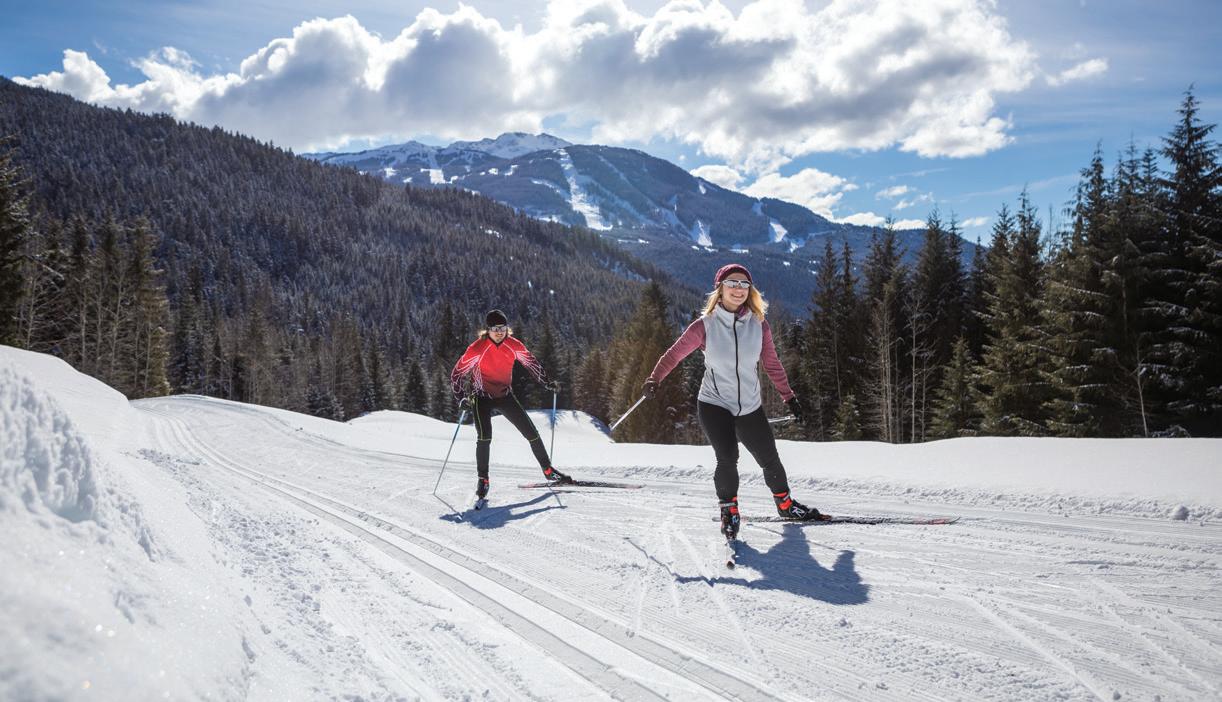

“These [funds] will be directed towards fuel-thinning on 12 different priority areas around the interface of Whistler, and it’s critical to make advancements in these areas to thin the fuel in the event of a fire,” Gresley-Jones said.
“This is one of the three prongs of our Community Wildfire Resiliency Plan. We work heavily in FireSmart, protecting the perimeter areas through these treatment plans, and then working with homeowners
“So this grant will make a significant difference for this valley.”
Councillor Arthur De Jong noted that wildfires are the most significant hazard to the RMOW, as forests cover 75 per cent of the municipality’s area.
“Wildfires have been identified as the highest climate change risk in Whistler, with an increased risk of wildfire and wildfire smoke events each year due to climate change,” De Jong said.
Whistler will become substantially drier and more at risk to fire.



“It’s not a question of if we’re going to see a catastrophic fire here; it’s only a question of when,” De Jong said. “Given the rate of climate change, which is much faster than what originally the IPCC thought, this is so timely to get this money to accelerate [mitigation efforts].”
The planned treatments will help establish a fire prevention perimeter around the municipality and help fund the implementation of more FireSmart measures, as well as provide a stable source of funding for the municipality to implement its mitigation efforts.



and our fire department to ensure that we have all of the buildings and structures protected and that we have access should we need to undertake fire prevention.”
A grant of this size, spread across multiple years, “provides stability and funding to be able to plan effectively, and have a long-term vision and be able to implement that,” Gresley-Jones added.
“It is in Whistler’s best interest to prevent and plan for these occurrences as soon as possible to the best of our ability.”
Climate modelling produced for Whistler’s Big Moves Climate Strategy indicated that the average air temperature will rise 4.5 C by 2080, and droughts will become increasingly frequent due to climate change. The forests in and surrounding
“The last couple of years have shown how much more prepared we need to be for the effects of climate change,” Weiler said. “It’s not just wildfires, it’s droughts. The first state of emergency ever in B.C. for drought is on the Sunshine Coast, and it’s still in effect in mid-November. So that’s a wake-up call.”
In its latest budget, the federal government earmarked a $1.3-billion increase in the Disaster Mitigation Adaptation Fund, which is where Whistler’s $10-million mitigation investment is coming from. The government is also creating a National Adaptation Strategy, which will be released at the end of the year. n
“It’s not a question of if we’re going to see a catastrophic fire here; it’s only a question of when.”
- ARTHUR DE JONG








 BY STEFAN LABBÉ
BY STEFAN LABBÉ
KATHIE RENNIE remembers the snow turning to rain somewhere around Cache Creek, near the turnoff from Highway 97 to Highway 99.
A road-crew operator from Maple Ridge, she had always hated taking Highway 99 home from her cabin at Green Lake, near 70 Mile House. She never trusted that enough work had been done to keep the road clear and safe from falling debris.


On Monday, Nov. 15, 2021, however, she had few choices. A day earlier, a powerful storm system had arrived, triggering flooding that swallowed homes in communities like Abbotsford, Merritt and Princeton.






More than 17,000 people would soon be stranded or displaced, some escaping the rising water in trucks, RVs, jet boats and kayaks.

The floods and debris torrents crippled major roads and bridges, drowning huge swaths of the Trans-Canada Highway and largely cutting off land access between B.C.’s coast and the rest of the country.


Rain or not, Rennie and her husband had to get to work, and their 10-year-old
son had school. But there was only one way home—a mountainous corridor along Highway 99 known as the Duffey Lake Road that snaked its way through the towns of Lillooet and Pemberton to eventually reach Metro Vancouver.
“It was like, hey, well, let’s just give it a shot,” said Rennie. “We had no intention of stopping.”
By late morning, Rennie started seeing rocks “all across the road.”
With nowhere to turn, the family crept their Ford F-350 forward.



About 42 kilometres southwest of Lillooet, high above the highway, something much bigger was about to get in their way.


Taillights came into view. Something was blocking traffic. They got out and looked around the corner. A mudslide had thrown a massive field of debris in their path, blocking their last route home.


“There was no way we’d be able to drive over that. So we just parked in line with everybody else,” she said.
Within a few minutes, a bottleneck of traffic stretched behind them.
All hill slopes have a breaking point.
Sometimes the trigger is an earthquake, a poorly planned building site or shock waves from blasting. Sometimes a fire that burns a hillside can raise the risk of a mudslide across an entire watershed. More often than not, all that’s required is gravity, a steep incline and the right amount of water.
In the fall of 2021, weeks of steady rain and warm temperatures had primed many mountainous areas across the province for slides. Rain and snowmelt had seeped into the spaces dividing dirt, rock and roots — slowly lubricating the earth.
Then the torrential rains came, pushing the soil’s friction to its limit. In an instant, the force of gravity overpowered the ability of innumerable hillsides to hold themselves together.
Untethered from the mountainside, morasses of soil and stone barrelled downhill at 30 to 60 kilometres per hour, ripping trees up by the roots, and often sending boulders into a “surge front” ahead of the mudslide.

In other parts of the province, at least 1,200 landslides combined with floods to wipe out 36 major sections of highway.
On the Duffey Lake Road, Rennie remembers feeling it before she could hear it. “It felt like an earthquake,” she said, a “huge rumble” and a symphony of trees
snapping “like a million twigs.”
She stepped out of the truck into a scene of mayhem. Behind them, the line of traffic ended in a towering soup of mud, boulders and splintered trees. Roughly 50 vehicles were trapped between two mudslides.
People were screaming “Oh my God, we’re going to die,” recalled Rennie. Others ran down the road yelling into vehicles for anyone who knew first aid.
Rennie had studied to become a paramedic decades ago. She told her husband to stay in the truck with their son “no matter what” and climbed out. Slipping between cars, she found a handful of other people looking to help.
“There’s just a group of us that came together as leaders, so to speak,” said Rennie, pointing to a forester, a fireman and an officer in charge of inspecting commercial trucking. “We never even introduced ourselves.”
The debris field towering over her head settled and flattened down the road, Rennie said. She began directing vehicles out of the way. “We were afraid that it was going to start wiping out cars.”
A few minutes later, a horrible realization settled on them—there were




















people caught in the mudslide.
Two women and a dog climbed out of a half-buried vehicle. A man, later identified as 36-year-old Brett Diederichs, must have seen it or heard it coming, said Rennie.
“He was outside of the vehicle and shoved his mom in the vehicle [with his partner] and slammed the door,” said Rennie. “He was gone … they survived.”
Dozens of people trapped between the two slides grabbed shovels, tire irons and two-by-fours—anything they had in their car. They started digging.
Down the valley, the members of Pemberton Search and Rescue heard their pagers go off at 11:59 a.m. Within the hour, helicopters had landed the first of 22 rescuers who would eventually scour the scene over three days, according to SAR manager David MacKenzie.

On the north end of the slide, Max Paulhus and his team from the Lillooet and District Rescue Society jumped in their truck and sped down the highway. The team regularly carries out rescues in rapids, off the sides of cliffs, and on highways. When they arrived, RCMP units were already diverting traffic.
The rescue teams pulled out chainsaws, axes, shovels and pry bars—anything to get through the morass, said MacKenzie. “When we first get there, we’re not in a recovery mode. We’re still in a rescue mode,” he said.
Anyone not still trapped in the mud had left, and Paulhus remembers thinking the mountain could slide down again at any time. “One minute, I’m standing on a log; the next, I’m up to my waist in three feet of mud and rock,” he said. “You find a fender and you just start digging.”
The Jaws of Life was brought down the hill, a hydraulic rescue tool that can pry open roofs and doors like a giant can opener.
Paulhus remembers finding the first victim. And then another.
Over the coming days, rescuers would find the bodies of 53-year-old father Steven Taylor, Anita and Mirsad Hadzic, parents to a two-year-old, and another 61-year-old man, who has not been publicly unidentified.
Diederichs’ remains have not been found.
The five slide victims would be the only ones directly killed by the natural disaster sweeping across the province. But soon, their deaths would be blamed on more than a force of nature.

Disturbances from logging roads and wildfires are priming B.C.’s forest slopes for failure, say experts. That’s compounded by human-caused climate change, which is expected to drive more frequent and intense rainfall during the province’s fall, winter and spring.
One 2020 study from a researcher at the University of Victoria-based Pacific Climate Impacts Consortium found climate change
could increase the frequency of landslide hazards in B.C. by a third by 2050. On the West Coast and in the northern Rocky Mountains, the number of days where hazardous landslides are a risk could climb by eight to 11 days per year.
On Vancouver’s North Shore, the destructive consequence of climate change could increase the risk of landslides by 400 per cent, according to a study produced last year by the late Vancouver geoscientist Matthias Jakob with BDC Engineering.
“It is sobering, but it falls in line with many other climate-change predictions. Predictions have, for most geophysical phenomena, become more dire, not less,” Jakob told the North Shore News just two weeks before the landslide hit Highway 99.
Jakob, who recently died in a paragliding accident, was set to testify as an expert witness in the proposed classaction lawsuit filed against the province last March, and set to be heard in court next spring. The Hadzics’ daughter is listed as the lead plaintiff.
The proposed class-action lawsuit against the province and a roadmaintenance company claims they should be held liable for not assessing Duffey Lake Road hazards— including risks posed by a logging road above the highway—at a time the corridor was being used to funnel traffic to the coast.
“If this [logging] road had been properly permanently deactivated, the potential for mudslides would have been detected and preventatives measures put in place,” the suit claims.
None of the claims have been tested before the courts. A spokesperson for the Ministry of Transportation and Infrastructure declined comment, as the case is before the courts.
A year later, the lives of those lost at the Duffey Lake Road landslide continue to weigh heavily on family and friends. Those involved in the rescue, meanwhile, say the days of searching still haunt them even after multiple critical stress debriefings.
“It was a very hard thing to deal with,” said Paulhus. “You don’t really want to go home and tell your wife what you did. You can share some things—and some things, you can’t.”
This story has been condensed from its original version. Find the full story at piquenewsmagazine.com.
With files from Brent Richter/North Shore News. n
“It was a very hard thing to deal with. You don’t really want to go home and tell your wife what you did.”
- MAX PAULHUST h e A rc ' te r yx Backcountr y Ac ademy is coming to Whistler for snow inspired educ ational clinic s, film premiers, live music and much more Scan the QR code to learn more and secure your clinic spot today LE ARN MORE

WHISTLER RCMP nabbed eight impaired drivers from Nov. 8 to 14, all late at night or in the early morning.
Five out of eight of the drivers were visitors to the resort. Three told police they hadn’t consumed any alcohol. In six of the investigations, drivers failed breath sample tests and received a 90-day driving prohibition, as well as having their car impounded for 30 days.
In the other two investigations, the drivers showed signs of impairment but their breath samples registered as “WARN,” prompting police to issue one three-day and one 24-hour driving prohibition.
The eight encounters were part of 100 files opened by local police from Nov. 8 to 14.
Two men and a woman allegedly stole a North Face pullover jacket from a store located at the 4300 block of Main Street on Nov. 13 at about 11 a.m.
But police say that might not be all they took.
The trio was also spotted in several athletic and outdoor shops the day before and the day of the alleged theft. Whistler Blackcomb also suspects the same three people might have taken other items from stores. The mountain operator is working


Only one vehicle received a Notice and Order for having summer tires.
“Members also provided information to several drivers on acceptable tire tread depth,” according to a release. “Overall, members were impressed with the number of vehicles equipped with winter tires.”
On top of having appropriate tires,
“Winter seemed to happen overnight this year,” said Cpl. Angela Kermer of the Sea to Sky RCMP, in a release. “We don’t have control over the weather conditions, but we can sure prepare ourselves with proper equipment and safe driving choices. We also need to remember that we can’t rely on others to be making the same safe choices, so situational awareness is very important as we travel.”

Police received a call on Nov. 6 after someone found three credit cards and a credit card application in the mail, all in their name— only they hadn’t applied for any.
with police to identify and locate the alleged thieves in the hopes they don’t steal from any other stores.
Police recently stopped about 500 vehicles at different check stops in the Whistler area to ensure they had winter tires.
police also urge drivers to: winterize their vehicles; pack an emergency kit; learn and practice winter driving techniques; plan their trip, let friends or family know the plan, and check road and weather conditions; remove snow from vehicle before each trip; allow extra time and adjust to conditions; avoid overdrive and cruise control when the road is slippery; and make sure cell phones are charged for emergencies.
The complainant didn’t lose any money, but police urged them to follow up with their bank and Service Canada to find out how their personal information got in the hands of fraudsters.
The banks involved are following up, police said in a release.
Police ask anyone with any information regarding the above files to contact the Whistler RCMP at 604-932-3044, or contact
Crime Stoppers at 1-800-222-TIPS, or go to the website solvecrime.ca. n
“Members
Purpose: The purpose of the proposed Bylaw is to designate Temporary Use Permit (TUP) areas for the retail sale of cannabis and specify general conditions regarding the issuance of TUPs for the retail sale of cannabis including minimum required distances between cannabis retail stores and schools and maximum number of cannabis retail stores

Bylaw Readings: Council gave the proposed Bylaw first and second readings on September 20, 2022
To learn more: A copy of the proposed Bylaw is available for review from November 17, 2022 to November 29, 2022 at:
• Municipal Hall at 4325 Blackcomb Way, Whistler, BC , during regular office hours of 8:00 a.m. to 4:30 p.m., Monday to Friday (statutory holidays excluded)
• Online on the Resort Municipality of Whistler (RMOW) website at: whistler.ca /Bylaw237 1
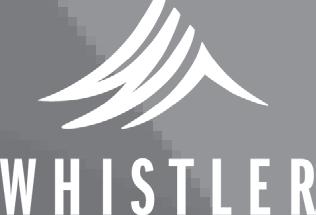
How to provide input: All persons who believe that their interest in property is affected by the proposed Bylaw will be given an opportunity to provide writ ten and verbal comments that will be considered by Council as follows:
1. Submit writ ten comments to Council via email: corporate@whistler.ca (must be received by 3:00 p.m. on November 29, 2022) include “Public Hearing for Cannabis Retail Bylaw 237 1” in the subject line, address the comments to “Mayor and Council”, and include your name and mailing address in the email); and/or
2 . Submit writ ten comments to Council via mail/hand delivery: Resort Municipality of Whistler, Legislative Services Department, 4325 Blackcomb Way, Whistler BC V8E 0X5 (must be received by 3:00 p.m. on November 29, 2022) (include “Public Hearing for Cannabis Retail Bylaw237 1”in the subject line, address the comments to “Mayor and Council”, and include your name and mailing address in the let ter); and/or
3. Provide verbal comments at the Public Hearing via online video or phone conferencing: Visit whistler.ca /Bylaw237 1 or scan the QR code below for instructions on how to access and participate in the Public Hearing . The Public Hearing link and phone numbers are also below.
After the conclusion of this Public Hearing , Council cannot receive further input from the public on the proposed Bylaw. SCAN THE QR CODE FOR A COPY OF THE PROPOSED BYLAW AND BACKGROUND DOCUMENTATION



ON NOV. 23, the Squamish-Lillooet Regional District (SLRD) board will reconvene with a few new faces and more power in the hands of the District of Squamish and Resort Municipality of Whistler.
Thanks to the rapid growth of Squamish in the last census, the municipality has been granted another seat on the SLRD board, bringing its total to three representatives.
Squamish’s new mayor, Armand Hurford, welcomed the news.
“We’re pleased to have an additional director seat and increased votes as a result of Squamish’s population growth,” Hurford said in an emailed statement.
“As a gateway for the corridor and the most populated community within the Regional District, it is natural for Squamish to provide important resources for the surrounding communities, from recreation, to shopping and services, to health-care.”
But providing those resources to other communities comes with responsibilities, too, “and so it is important to have a strong voice on projects and initiatives that may impact us,” Hurford added.
“My council colleagues and I look
forward to continuing the important and productive work with the SLRD board on shared interests and pressures stemming from growth across all our communities.”

With the expansion of the board, the District of Squamish also gains three additional votes, bringing the district’s total to 13.

population. Squamish is one of the fastestgrowing communities in the province, rising from 19,497 to 23,819 people, a 22-percent increase between 2016 and 2021.
Whistler grew by 19 per cent, from 11,746 to about 14,000 people. While Whistler’s population growth is substantial under the current formula, the





Mack, Vivian Birch-Jones and Sal DeMare. The new faces on the board are Armand Hurford, Squamish Councillor Chris Pettingill, and Lillooet’s new mayor, Laurie Hopfl.
Find more info at slrd.bc.ca. n


SQUAMISH (POP: 24,327)

3 representatives, 13 votes WHISTLER (13,982)


2 representatives, 7 votes
- JACK CROMPTON

The Resort Municipality of Whistler, meanwhile, is also gaining another vote at the board table, bringing its total to seven to reflect the resort’s surging population.



“These changes are more evidence of our quickly growing region. I am excited to get back to work with the great group at the SLRD,” Whistler Mayor Jack Crompton said in an email.




Over the last five years, nearly every part of the SLRD experienced a surge in










RMOW does not meet the threshold for an additional seat on the board.



The new SLRD board will be filled with familiar faces, as all incumbent directors were acclaimed in the October election.
From the member municipalities, Crompton, Whistler Councillor Jen Ford, Pemberton Mayor Mike Richman, and Squamish councillor Jenna Stoner will all return to the board along with incumbent area representatives, Tony Rainbow, Russell


ELECTORAL AREA C (3,492)


1 representative, 2 votes
VILLAGE OF PEMBERTON (3,407)
1 representative, 2 votes
LILLOOET (2,302)
1 representative, 2votes.
ELECTORAL AREA B (1,624)
1 representative, 1 vote
ELECTORAL AREA D (1,057)
1 representative, 1 vote
ELECTORAL AREA A (305)
1 representative, 1 vote
TOTAL: (50,496)
11 representatives, 29 votes.
Amendment Bylaw (7104 Nancy Greene Drive) No. 2370, 2022 (the “proposed Bylaw”) Tuesday, November 29, 2022 @ 5:00 p.m. Via Zoom Online/ Telephone
Purpose and Subject Lands: The purpose of the proposed Bylaw is to rezone the subject lands from Residential Single Estate One (RS -E1) Zone to Residential Multiple 75 (RM-75) Zone, a site specific multi-family zone to permit a 36-unit employee-restricted rental apartment building The proposed bylaw specifies density, building height, size, and siting , and minimum parking requirements, and restricts the building use to employee rental

Bylaw Readings: Council gave the proposed Bylaw first and second readings on September 20, 2022
To learn more: A copy of the proposed Bylaw is available for review from November 17, 2022 to November 29, 2022 at:
• Municipal Hall at 4325 Blackcomb Way, Whistler, BC , during regular office hours of 8:00 a.m to 4:30 p.m., Monday to Friday (statutory holidays excluded)

• Online on the Resort Municipality of Whistler (RMOW) website at: whistler.ca /RZ1146
How to provide input: All persons who believe that their interest in property is affected by the proposed Bylaw will be given an opportunity to provide written and verbal comments that will be considered by Council as follows:
1. Submit writ ten comments to Council via email: corporate@whistler.ca (must be received by 3:00 p.m. on November 29, 2022) include “Public Hearing for RZ1146” in the subject line, address the comments to “Mayor and Council”, and include your name and mailing address in the email); and/or

2 Submit writ ten comments to Council via mail/hand delivery: Resort Municipality of Whistler, Legislative Services Department, 4325 Blackcomb Way, Whistler BC V8E 0X5 (must be received by 3:00 p.m. on November 29, 2022) (include “Public Hearing for RZ1146” in the subject line, address the comments to “Mayor and Council”, and include your name and mailing address in the letter); and/or
3. Provide verbal comments at the Public Hearing via online video or phone conferencing: Visit whistler.ca /RZ1146 or scan the QR code below for instructions on how to access and participate in the Public Hearing . The Public Hearing link and phone numbers are also below
After the conclusion of this Public Hearing, Council cannot receive further input from the public on the proposed Bylaw.
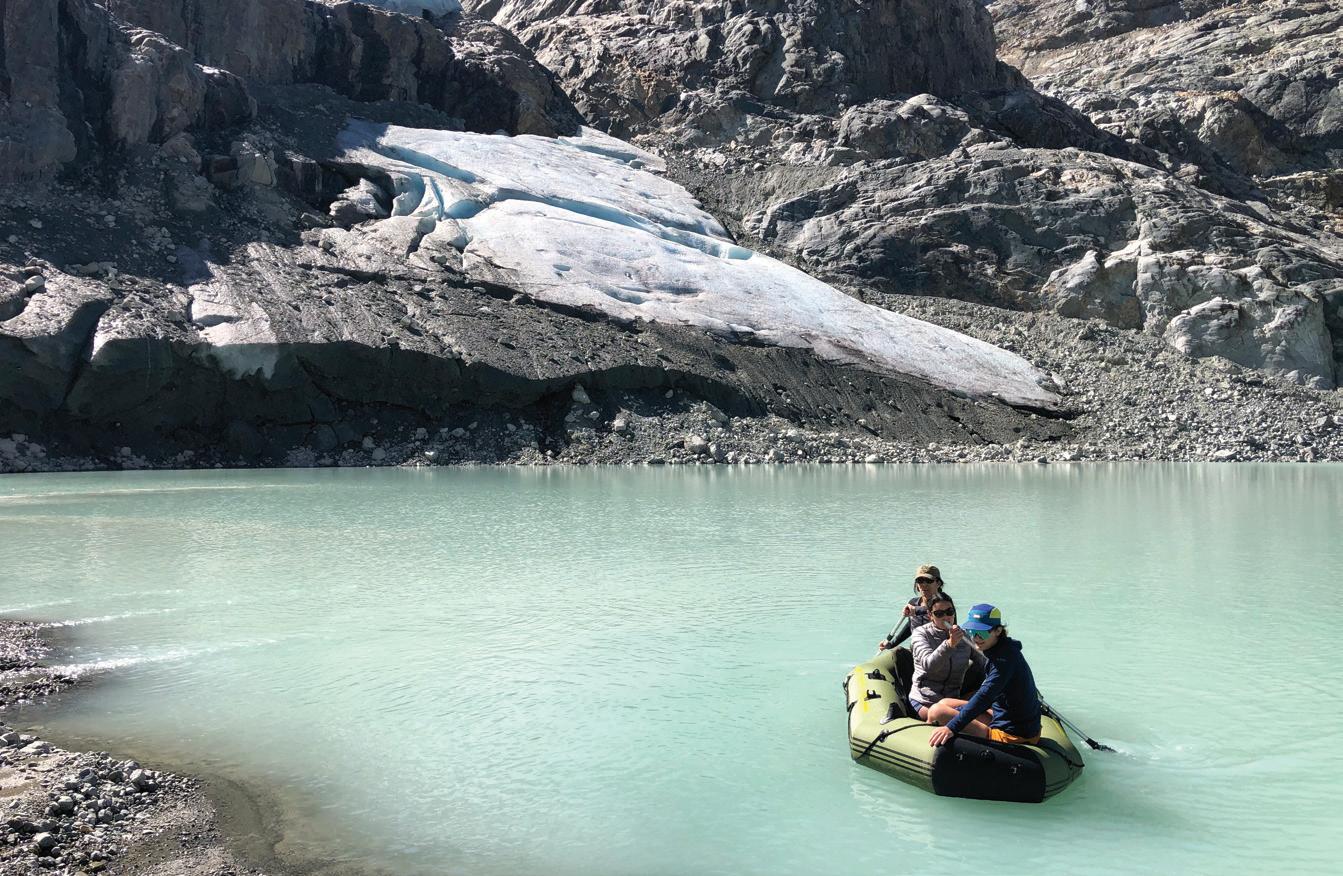 BY KARL RICKER
BY KARL RICKER
MORE MULTI-GENERATION family members joined the annual Wedgemount Glacier survey on Sept. 3, and confirmed that the glacier is receding at alarming rates. This year, second-generation researcher Rob Tupper, our key surveyor, brought his daughter, Brooklyn, along with boyfriend Liam—both University of Victoria students in earth and ocean sciences, and that spells great surveys to come. Another secondgeneration researcher, Dave Lyon, was accompanied by his daughter, Rebecca, and an exchange student from Germany, Florentina. Kristina Swerhun organized the operation at the glacier.
One focus of this year’s survey was to map the depth of the now fully emerged Tupper Lake, located about 350 metres up the valley from Wedgemount Lake and at an elevation of 1,910 metres, or 50 metres higher. The glacier recession from lake to lake was over uneven, rocky ground, but it is surprising how foot traffic has generated a trail between the two.
Tupper Lake is so named after the instigator of the Wedgemount survey beginning in 1973. Bill Tupper was a photogrammetrist (meaning he used photos to help survey), teaching the topic
at B.C. Institute of Technology (BCIT). He passed away in 2005. His son Rob, a survey engineer, is now carrying the torch.

The first task upon arrival was to take depth measurements of Tupper Lake from an inflated raft. One hundred measurements on about four hectares of lake surface provided a max depth of 12.5 metres.
Meanwhile, Dave and assistant, Bronwyn, hiked up the steep rock rubble to the present glacier terminus on the crest of
a cliff band to build a new cairn/monitoring station, revealing eight metres of horizontal ice retreat over the year. The rise from the lake to the cairn is 63.7 metres, indicating a very abrupt step up in retreating ice from 2020 to 2021. The plotted bathymetry (depths) will provide a volume of water in Tupper Lake.
Next, Rob hiked onto the ice to locate a BCIT station from 2020. Once found, it revealed significant thinning of the ice
(surface ablation). In two years, the height of the ice had diminished by 5.7 metres—a surprising amount given the high elevation of ice which now begins at 1,974 metres. The survey party then descended to Tupper Lake to conduct an exact perimeter survey.
Tupper Lake underlies the former junction of the Mount Weart and larger Wedge Mountain arms of Wedgemount Glacier, with about 110 metres of ice thickness in 1977. By 2016, there were floating icebergs in the lake, but no intact glacier on it, which tells us that 39 years of surface ablation is about 2.8 metres per year.
As a final gesture for the day, the ashes of Bert Parke, one of Bill Tupper’s helpers in the 1970s and ’80s, were scattered about trig station No. 6 above the Wedgemount hut. Bert passed away in March 2022.
What is in store for the future? Glacier recession is expected to decrease to values less than eight metres per year as experienced in the 1970s and early ’80s. This is because the ice is now at a higher elevation, where it is cooler, so the annual ice melt should decline. Will this be confirmed? The new family chain of surveyors has a job to find out!
Naturespeak is prepared by the Whistler Naturalists. To learn more about Whistler’s natural world, go to whistlernaturalists.ca. n







 BY MEGAN LALONDE
BY MEGAN LALONDE
THE SUN HAD long since set when Reuben Bikadi’s phone rang.
The call came in just after 9:30 p.m. on Oct. 23 from a neighbour, Adelaide Leo. A young member of the Mount Currie community had gone for a Sunday afternoon hike, but had gotten disoriented once the sky darkened. Could Reuben help find him?
He didn’t hesitate. The 35-year-old and his younger brother Logan Bikadi, 30, had received several similar calls before. The pair grew up hiking in mountains on Lil’wat Nation territory, and both spend much of their workdays navigating rough backcountry terrain—to say they know the area well would be a gross understatement.
“I didn’t think it was too serious at that time, so I jumped on my quad and said, ‘OK, I’ll go have a look,’” Reuben recalled. Based off the general location Leo provided, “I just assumed maybe he was right on the road or beside the road.”
Luckily, the hiker still had cell service. By 10:30, Reuben had found the hiker’s number and connected with him directly. “I asked him, ‘where are you exactly?’”
The hiker told Reuben he travelled along a road to the highest possible point before continuing to climb a ridge, eventually hanging a slight left. There’s an “old ancestor trail” in the area, but no designated hiking paths, Reuben explained.
“He said there were rocks around him. And I thought right away, ‘like, oh my God, rocks mean you’re at the top of the mountain,’’ he said. “And the worst part of the mountain, actually, it’s cliffs with slides; very steep.”
Reuben beelined for his parents’ house to collect flashlights, batteries and, most importantly, his brother Logan. What followed was a nearly 12-hour ordeal that
started with the brothers scaling 1,200 metres of elevation over two kilometres in just three hours, and ended on a longline dangling under a search-and-rescue (SAR) helicopter the next morning.
“I think we were walking for about 200 metres, if that, and then pretty well crawling the rest of the way up,” said Reuben. “It’s that steep.”
Throughout the trek, the Bikadis were able to stay in touch with the hiker through texts and phone calls, eventually adding him on Snapchat and using the app’s
map feature to pinpoint their respective locations. Logan, a forestry field tech, also brought along contoured topographic maps charting the terrain’s steepness. The brothers consulted between the two, eventually making their way up a chute, over a cliff band—“that’s actually where we reached the snow, and it started snowing on us,” said Reuben—and through a dense thicket before seeing the hiker’s flashlight shining through and hearing him call out. It took the brothers just over three hours to reach him from the valley. “I’ve climbed
that mountain in the past, but it took me six hours, not three,” said Reuben. “We cut that time in half.”
According to Environment Canada, temperatures on Oct. 23 reached a low of -2.5 degrees C in the Pemberton area, while Oct. 24 brought 9.8 millimetres of precipitation to the valley.
The brothers found the hiker, who they estimated to be about 20 years old, about 250 metres below the mountain’s summit, uninjured and armed with a spare phone battery and snacks but “completely hypothermic,” said Logan.
Added Reuben, “It got dark really fast on him. This was his explanation … he did try to come down the chute where we went up, which was, like, beyond dangerous—we even said, ‘we’re not coming back down this way.’”
The brothers pulled off the hiker’s wet gear, bundled him in Logan’s warm wool sweater, covered that up with his windbreaker and held the hiker close until his body temperature and breathing started to regulate. “I opened my coat up and I put him inside my coat, his head against my chest,” said Reuben. “I just held him there until he calmed down.”
Added Logan, “It took 20 minutes alone just to fix his breathing.”
Eventually, the three men scrambled their way downslope to a sheltered location under a cluster of trees near a clearing, digging into the steep terrain to carve out “a bed” for the hiker and a flat area to build a fire.
By that time, SAR crews had assembled in the valley and instructed the three men to stay put. A call had been put out for a night vision helicopter, said Reuben, but the chopper barely made it to Squamish before poor visibility forced it to turn back.
All three men were eventually airlifted out via longline and dropped off in a Mount Currie school field at 10:30 a.m., more than

WHEN WILL MILLER and his family opened their own microbrewery, The Beer Farmers, in 2018, they hoped to draw more people to their longtime home of Pemberton while standing out as one of the few breweries in the province that grows its own barley. Four years later, the BC Beer Awards have taken notice.

At the BC Beer Awards in Vancouver on Nov. 5, The Beer Farmers won the overall Judges’ Choice Award for their Farmer’s Daughter White, a traditional Belgian-style wheat beer spiced with orange peel and coriander that also beat out 15 others in the Belgian Ale category. Miller’s operation also earned third place in the Specialty Wild Ale category for its Rose & Hibiscus Sour, while Whistlerbased Coast Mountain Brewing took second in North American Pale Ale.

For Miller, the awards are a welcome reassurance that he and his family’s hard work is paying off.
“Definitely, it can be a good foot in the door,” he said. “[Our Farmer’s
Daughter White] is beer that we’ve always made since Day 1. It’s nice to be able to make a more classically styled beer and have it recognized instead of having to do something that’s super fancy. It’s something that anyone might enjoy.”
Farmers by trade, the Millers and their ancestors have worked on Pemberton-area fields for about 120 years. Today, they grow their own hops and barley as a nod to their agricultural roots. According to Miller, barley is underappreciated in the beer industry despite representing “99 per cent of the ingredients in beer.” He and his family are happy to offer guests a change of pace from the Manitoba-grown barley found in most B.C. beers, he added.
As word of mouth has spread, The Beer Farmers have entertained a diverse clientele in the past few years. Many visitors frequent their tasting room, but some of those out-of-towners are pulled in by enthusiastic locals won over by the Millers’ brand of Saison and Belgian beers. Miller and his team prefer to use their homegrown ingredients in lighter, specialty styles that accentuate nuances
FROM PAGE 28
eight hours after first locating the hiker.
“When we got to the last, maybe, 100 feet off the ground, he looked at me and said ‘thank you,’” Reuben recalled. “I looked at him and said, ‘I told you I was going to get you off that mountain one way or another’ and he just broke right down.
“He couldn’t stop saying ‘thank you.’”
In a statement posted to the Lil’wat Nation’s official Facebook page, Chief Dean Nelson thanked the SAR teams and first responders who participated in the search, but recognized the Bikadi brothers in particular for “their selfless acts of community.”


The brothers, said Nelson, “took it upon themselves to make their way through the dark, steep and dangerous terrain” to find the missing community member. “Without Reuben and Logan’s selfless actions in this incident things would have been extremely dangerous with the winter weather moving in,” Nelson said.
Both brothers agreed it’s the “most major” rescue mission either have been a part of.
“But the way we were brought up, we just kind of knew what to do,” said Logan. “Everything fell into place.” n
NAIRN FALLS PROVINCIAL Park will remain open for winter, thanks to funding from the Squamish-Lillooet Regional District (SLRD) and Tourism Pemberton.
At the SLRD’s Nov. 9 electoral area directors meeting, directors approved $4,000 from the SLRD Area C select funds to cover some of the costs for plowing the popular provincial park’s parking lot, located just south of Pemberton on Highway 99.


Tourism Pemberton will cover the remaining $2,000 of the estimated $6,000 needed to keep the parking lot clear during the season.
Nairn Falls staying open during the winter for day use was first successfully piloted in the 2020-21 winter season. The pilot came as the number of people illegally parking on the side of the highway to access the park became an increasing safety concern.
The provincial park staying open through the winter also enables local crosscountry ski programs to continue operating in the area.
“Tourism Pemberton has been working with BC Parks since 2021 to provide safe access to Nairn Falls Provincial Park, a wonderful community amenity,” said Tourism Pemberton vice president Mark Mendonca, in an email, adding that BC Parks has declared the project is no longer a pilot program.
“During the winter season, snow in the main parking area caused locals and visitors alike to park on the highway in order to access this beautiful park. This was a dangerous situation reminding us of the problems we had at Joffre [Lakes Provincial Park],” Mendonca said.
“This year, we would like to thank the SLRD and area director Russell Mack for their contribution. Tourism Pemberton now shares the financial responsibility with the SLRD to provide snow clearing, safe access to the park, and, of course, to the groomed cross-country trail.”
The park will follow the same rules and hours as last year’s pilot project. There will not be any overnight parking allowed in the day-use area, and if overnight parking occurs, BC Parks will return to a closed-gate operational model.
The public is welcome to access the groomed ski tracks in the provincial park for cross-country skiing only, and the walking trail to Nairn Falls will also remain open.
Walkers are requested to stay off the groomed ski tracks at all times, follow signage, and stay on designated recreational access trails to avoid damaging the Nordic trails.
Highway parking continues to be a problem for nearby provincial parks closed for the winter season.
One example is Brandywine Falls Provincial Park, south of Whistler, where more than a dozen automobiles regularly park in front of the park’s closed gate. Currently, BC Parks has not announced any additional plowed parking pilots.
“Brandywine Falls Park remains open during the winter months, but parking or vehicle access into the park is not provided,” a spokesperson with the provincial Ministry of Environment and Climate Change Strategy said in an emailed statement.
“The two primary locations for pick up and drop off are along Highway 99 and via the CalCheak Forest Service Road. People can also access the park via the Sea to Sky Trail system. Due to public safety concerns, the Ministry of Transportation prohibits parking outside the gate and will be enforcing this throughout the winter months.”
At Joffre, meanwhile, the province is conducting snow clearing as part of the Visitor Use Management Strategy in collaboration with Lil’wat and N’Quatqua Nations, the spokesperson added.
Nairn Falls Provincial Park is a popular attraction 20 minutes north of Whistler, within the boundaries of the Village of Pemberton. The provincial government created the 170-hectare park in 1966.
The park is connected to Pemberton via the One Mile Lake Trail and will soon be fully connected to the rest of the Sea to Sky Trail to Whistler. n
FROM PAGE 29
in flavour, he said. An innovative new flavour is slated to join the lineup in a few weeks as well, he added: a barley-based collaboration between The Beer Farmers and two other B.C. breweries.
After seeing “a lot of different versions” of his hometown through the years, Miller is excited that his family business can be part of the growth spurt that Pemberton is experiencing.
“It’s really exciting and encouraging to see the town kind of growing up, and, you know, it’s nice to see more options, different things to do,” he said. “Especially younger people moving here and the
creativity, and the sort of reinvention that that brings.”
Even as The Beer Farmers team looks to be creative in developing new and exciting products, they remain committed to the family-oriented hospitality that got them this far. Miller fully intends to continue earning the trust of his customers, including the latest influx of newcomers.
“We really put our name on things and [we take] the pride and also the pressure that comes with that,” said Miller. “So, you know, we’re pretty careful, we’re slow and methodical. And we want to make sure we get it right.” n
April 8, 1959 November 1, 2022




Marilyn Sorensen-Graham passed away peacefully, November 1, 2022, in Oliver BC. Marilyn spent many years in Whistler before moving to Oliver to continue her holistic work. She was well known in the massage and aesthetician community for her passionate and educated approach to her profession. She was a ‘Spa Mama’ to many of her co-workers; always advising and helping to teach new techniques to whomever asked. She was a trained teacher in several different modalities, offering courses to those wanting to fur ther their education. When speaking of our dear friend, one cannot over emphasize the kindness and loving nature she had. She always had time to listen, offer sound advice, or be a voice of reason. She was a generous, loving and truly endearing woman. We shall miss her, and always cherish the imprint of love and grace she left on us all.































































































































































































































































































































































































































































































































































































































































































































































































































































































































































































































































































































































































HEY PEOPLE —it’s winter! There’s not a ton of snow yet, but I’ve already had my first day on skis (OK, it was cross-country at Callaghan) and my mind has officially moved into alpine-anticipation mode. And you know what that means: skis ready, boots fitted, and backcountry gear checked, sorted and packed—including making sure my
BY LESLIE ANTHONYavalanche transceiver is in good shape. I’ll bet a lot of you are doing the same, but have you ever wondered how avy transceivers came into being? Well, if you have, I’m here to fill in the blanks for you.
People working in snow country in both Europe and North America had long lamented the difficulty of efficiently finding victims buried in avalanches. Back in the day, the only tool at their disposal was the wooden probe, which was both unreliable and inefficient—by the time a buried victim was actually found they had usually expired. By the mid-20th century, however, the avyrecovery conversation had settled on the idea for a compact, personal electronic device, worn by all in a backcountry party, that would not only transmit a signal in case someone was buried, but also double as a receiver that non-buried individuals could use to search for victims—hence the portmanteau transceiver
The first such device (a.k.a. “avalanche beacon”) was invented in 1968 by Dr. John Lawton at the Cornell Aeronautical
Laboratory in Buffalo, N.Y. Legendary American snow scientist and avalanche expert Ed LaChapelle, who’d spent time at the snow research institute in Davos, Switzerland, worked with Lawton on the design. A commercial version— called a “Skadi” after the Norse god of the wilderness—hit the market in 1971.
By pulsing electricity through a copper coil, it radiated a dipole-flux magnetic field (think something that resembles a rounded bow-tie) with a signal transmitting at 2.275 kHz. The receiving part of the unit could pick up this signal and convert it into a sound heard through an earphone that became louder as users got closer to a victim. Still, maximum range for the signal wasn’t that great— about 27 metres—and the directional
in 1996. Only a year later, Colorado-based cottage industry Backcountry Access launched the first digital transceiver— the DTS Tracker—to much acclaim. Built around microprocessors that overcame some of the human-error in searching, it was both more user-friendly and faster working, offering a higher victim recovery rate. Cowed by this much greater level of utility, other manufacturers soon followed suit until digital became the new technological norm.
Digital transceivers use both signal strength and the dipole flux pattern to compute distance and direction to a buried transceiver; this requires at least two antennae, although most modern versions have three. Direction to the buried transceiver is indicated as an arrow on an LCD display,
complexity, backcountry newbies definitely don’t need to shell out for pro models. If you are a pro, however, you may appreciate the increased functionality of the premium versions: better search range, battery life and processing speed, detailed display graphics, and state-of-the-art features like a U-turn indicator to keep you searching in the right direction. Regardless of your place on this continuum, digital tech marches on, and what comprises “basic” in a beacon is evolving quickly.
Bluetooth (for downloading new software) has become an option, and last season saw the release of Ortovox’s “Diract Voice”—an innovative transceiver that issues verbal commands like “run,” “walk,” and “go down to the snow surface” to keep the searcher’s eyes in front of them rather than fixated on the device. It also has a rechargeable lithium-ion battery, setting it apart in a sea of beacons that use standard alkaline batteries.
 PHOTO BY ALEX RATSON / GETTY IMAGES
PHOTO BY ALEX RATSON / GETTY IMAGES
antenna was a crude approximation of what was actually needed.
In 1986, the frequency of most transceivers increased to 457 kHz to provide a greater range (50 to 70 metres).
Employed by a range of analog transceivers (the Ortovox F1 was a favourite for the next decade), the new frequency was adopted by the International Commission for Alpine Rescue as an industry standard, and eventually entrenched by the American Society for Testing and Materials, an international standardization organization,
and audio tones at varying pitch or frequency guide the rescuer to single or multiple-burials, each of which can be digitally flagged.
Generally speaking, beacons fit into two categories—those for recreational use and those geared towards snow professionals like guides, instructors, and patrollers. If you’re new to backcountry travel, simpler is almost always better. I can tell you from experience that if a slide happens, the last thing you want to be doing is scrolling through setting options trying to find search mode. Because cost always corresponds to
Future technological considerations include the capability of transmitting “live state” to searchers—i.e., letting a searcher know whether a buried individual is still alive—as well as who that individual is, a moral can of worms that much ink has been expended on (you can imagine the issues here). With backcountry travel growing by leaps and bounds, the current Holy Grail is a smartphone app that could be used as a transceiver, something the industry would either push back on, or take a lead role in licensing.
But this is getting ahead of the simple issue of being ready for the season. Is your beacon working? Do you have fresh batteries? Have you practiced your searching? Good— because the snow is coming.
Leslie Anthony is a Whistler-based author, editor, biologist and bon vivant who has never met a mountain he didn’t like.

Back in the day, the only tool at their disposal was the wooden probe, which was both unreliable and inefficient...
histler, as a collective, multicultural rendezvous of worldly pilgrims, offers a unique, yet highly dynamic ebb and flow of people. Historically, the area has been a place of meeting since the Lil’wat and Squamish Nations gathered together to celebrate and share their cultures.
To this day, Whistler continues to offer a special place of gathering, shared territory, and global connection. And what better place to come together and collaborate than the gratifying space of a local coffee shop?
This comforting coffee shop camaraderie was what I searched for as I first meandered around Whistler’s Village Stroll. In a disorderly state of traveller’s nirvana after nearly 20 hours of international travel, coffee was the only thing that felt rightly ritualistic. As a seemingly comforting adventure, coffee allows the adventurer to search for a cup of familiarity in a place unfamiliar to them. The search for a good coffee shop in an unknown locale can be an exciting (yet sometimes disappointing) venture.
Coming from the Australasian biographical realm of strong, archetypal, predictable coffee, my first sip of Canadian coffee evoked many nuanced flavour
profiles and questions. What kind of coffee language did they speak here? What characteristics constituted the perfect cup of Canadian coffee?
As I continued to ponder over my morning
cup, I had to ask myself—was Whistler’s

coffee culture a cup half full, or half empty? Does the resort boast a culture all its own? Or is indicative of the broader Canadian coffee conundrum? Although these questions may seem attenuated, they are overly ambiguous, as coffee is much more than just a cup of caffeine—it is a cup full of political, social, environmental, and cultural matters.


For many, coffee is an almost religious practice—a habitual, communal, eternal love. Today, in the 21st century, you could say coffee has become almost primal; a means to adequate functioning in an overbearingly stimulated, rambunctious world. Here in the mountainous geographical landscape of

beautiful British Columbia, coffee is a means to a day of multitudinous activities. Whether it is in between runs in the bike park, on hiking trails, or ski runs, coffee continues to be a proximate cause for vivid connections here in Whistler, as coffee communicates an underlying sense of correspondence, of unspoken understanding in a town full of different dialects and cultures. Although coffee is a universal language, it carries its own peculiarities, eccentricities, and idiosyncrasies. These subtle differences—whether the coffee is served black or with milk or called a latte or flat white—not only range from city to city around the world, but from one coffee shop to the next here in Whistler.
Whistler, in all its grandiosity, prioritizes the big, which is why it sometimes lacks the small, meticulously crafted coffee culture—at least on the surface. This apparent lack of crafted coffee is what Mat Peake and Chrissy Hay, owners of Hammer Coffee Roasting, saw almost 10 years ago when they first started to roast their own coffee in Whistler.
“We started roasting back in Australia about 15 years ago… then when we moved to Whistler we were dying for a great cup of coffee, and we couldn’t find one,” says Peake. “And so we started a little coffee club in Alpine, roasting in the backyard and facilitating the five customers we had at the time.”



time.”
Unconsciously influenced by their coffee experiences in Melbourne, Peake and Hay acknowledge that the Australian coffee culture is particularly special to them, and has been incorporated into the chosen caramel and chocolate notes they roast into their own coffee. “In terms of roasting, the industry standard in North America is to roast light, bright, acidic coffee. Whereas
says Hay. “Anything extra we give to the food bank.”
For the two Whistler-based coffee roasters, opening a café in Whistler was not in their vision, as the ever-changing staff would affect the consistency, taste, and precision of their coffee. “Instead, we chose to deliver our freshly roasted coffee right to people’s doors and let them have good quality coffee at home,” says Peake.
Both lovers of the outdoors and mad mountain bikers, Peake and Hay believe in creating a supportive, communitycentric coffee when it comes to Hammer—offering locals discounts and backing local organizations like the Whistler Off Road Cycling Association. “Our biggest mission with Hammer is to make sure those who have lived in Whistler for a long time and have made Whistler what it is today have continual access to good-quality, locally roasted coffee that is delicious,” says Hay. “Coffee is a daily ritual that I think everyone should have. It is this mysterious drink that makes everyone want to sit around and talk about things. It makes people stop.”
Despite the sometimes-difficult operating environment, the two feel extremely privileged to have Whistler right outside their window. In their sun-lit space located in Function Junction, Peake and Hay roast with sparks of optimism. “Every time we turn the



roaster on, we are slowly but surely changing the coffee culture in Whistler. It is all about slow growth,” says Peake.
“The coffee industry is massive, and so there is always something to learn. There is always a different region to roast, always something new on the market… but at the end of the day, it comes down to that cup; trying to operate outside of the fads and

First time to market! Built by Durfled Constructors

post and beam mountain home including a

bed suite above a
bay heated garage is ready for you and your family to enjoy Located in Whistler ’s prestigious neighbourhood of Green Lake Estates/Nicklaus North Golf Course, 8060 Nicklaus North Blvd is for the discerning buyer who appreciates quality craftsmanship and location This immaculate home sits just across the 1st hole tee boxes and only a few steps away from the iconic Nicklaus North Clubhouse From your doorstep you have access to picturesque Green Lake, Lost Lake Bike / XC Ski Trails, Valley Trail, Whistler Air float plane dock, River of Golden Dreams, and an award winning Jack Nicklaus designed golf course Zoned for nightly rentals this home offers the flexibility to generate revenue when not used personally
we try to roast more of an Italian-style

coffee—which is a more common style here in British Columbia,” explains Hay.
Although the Hammer Roasting duo focus on a specific roast that is bold—a medium to dark style—Peake and Hay like to be creative when it comes to crafting a colourful coffee palate. “When you remain playful within your own coffee experience, it can be really rewarding after a long time,” says Peake. “However, consistency is important, as coffee drinkers are pretty habitual. We have had people who have been buying the same coffee off us for six years. They buy it week in and week out— and they love it!”
Operating with a fundamentally bespoke approach to coffee roasting, Peake and Hay roast to order. “We don’t want any waste. And so I wait for all the orders to come in and then I roast like a mad woman,”
come down to that great cup of coffee in the

morning. I think if you keep going back to that, you will be fine.”
Although Canadian coffee culture lacks the coffee-drinking effervescence that many other countries seem to encompass, the average Canadian coffee drinker consumes about 14 pounds of coffee per year, according to various websites, like coffeeaffection.com—good enough for 10th place in the world’s top-10 list of coffee-drinking nations. Essentially, coffee in Canada is often about quantity over quality, as mega-franchised coffee drinking remains a fundamental way of life for many Canadians. Currently, there are about 4,000 Tim Hortons
restaurants in Canada—nearly one for every 10,000 Canadians. According to statistics, the majority of Canadians drink their coffee in the comfort of their homes, with Tim Hortons being the most popular brand to brew.
For the smaller, crafted coffee shops here in Whistler, making the effort to resist these North American superfluities and instead handle coffee with care is what it is all about. Over a lovely cup of hand-crafted coffee, Dakota MacDonald, manager and barista at Whistler’s ecologyst Café, expresses how she sees a certain Canadian coffee culture that prioritizes a quick caffeine fix, rather than a slow-paced, catch-up culture.

“A lot of people are in a rush and want things fast, so not a lot of care goes into things—unfortunately, coffee is one of those things,” says MacDonald.
“But coffee needs to be careful and patient, as precision is what makes coffee taste that much better.”
At ecologyst, MacDonald manages a range of baristas who come from all kinds of continents and coffee understandings. “Whether you are training someone from Ontario or training someone from Australia—their perspective on coffee is completely different,” she explains. “Here in Canada, it feels as though the perspective on coffee is that as long as there is caffeine in it, it is good. But coffee is far more complicated than that. You need to make sure it is at the right temperature and the right pressure so you can get the emulsified oils out. You also need to be careful not to over-extract or under-extract it.”
In contrast to Canada, in places like Sweden and other Nordic countries, coffee exists more as a concept, rather than a caffeinated drink. Fika, in Swedish custom, translates roughly as a “break from activity in which people drink coffee, eat sweet treats, and relax with others.” The slowpaced coffee culture that inhabits countries beyond Canada seems to grasp the value of coffee-drinking in its simplest form—a culture in which coffee is viewed as essential and habitual, yet careful and conscientious. There is a quote by Palestinian poet Mahmoud Darwish that beautifully articulates the art of coffee drinking: “Coffee should not be drunk in a hurry. It is the sister of time and should be sipped slowly, slowly. Coffee is the sound of taste, a sound for the aroma. It is the meditation and a plunge into memories and the soul.”
For MacDonald, coffee represents a feeling of comfort. “Especially when you move to a different country, the first thing you gravitate towards is something mundane— something normal and routine, something that reminds you of home. For many, that something is coffee,” she says. When asked what she believes goes into making the perfect cup of coffee, MacDonald’s answer is simple: “love and care.”
“As a barista, it is important to understand the weight of a cup of coffee, as

you are gifting someone their favourite part of the day or a little piece of home,” she says.
In terms of the barriers she faces as a coffee shop manager here in Whistler, MacDonald feels transiency is at the forefront. Although being able to make connections from all over the world has its blessings, MacDonald points out that “when the baristas change, or we get new staff, the coffee changes with it. But transiency is just a part of Whistler and is something business owners must grow accustomed to.”
Alternatively to MacDonald, Chris Ankeny, owner and founder of Mount Currie Coffee Company, views Whistler’s ever-changing diversity in a positive light, as he describes Whistler as “a melting pot of a melting pot of people from all over the world seeking adventure.” Ankeny believes the different cultural backgrounds of the baristas at Mount Currie Coffee to be a huge benefit
to the overall charisma of the café, as “all employees bring little bits of their culture and share their perspective on coffee making and good coffee service.”
Although Whistler is known as a town of vivid tourism, Ankeny takes pride in the idea of “small-town spirit,” and operates both his Pemberton and Whistler stores on the basis of community and meaningful connection. Mount Currie Coffee Co. makes the regular effort to support initiatives and programs around Whistler that combine
both the love of mountain biking and winter adventures. “That connection of community and adventure is what attracts people to the livelihood of the town and keeps them stoked,” says Ankeny. Although described by Ankeny as a “simple pleasure” and “a little cup of happiness,” he believes many things go into making a great cup of coffee. “From sourcing the right beans, to grinding them correctly, paying close attention to your extractions, and steaming the milk… it is a whole art form that is hard to nail. But when a barista can execute all of this with a smile—it is really a thing of beauty,” he says.
Since Mount Currie Coffee Co. first established itself back in 2007, Ankeny has seen continual growth in craft coffee and quality cafés in Whistler. “I feel that the more quality coffee, the better, as it raises everyone’s standards and forces us all to try harder and execute good coffee,” says Ankeny.
“In terms of ethics, there has been a big shift to a much more sustainable future. Here at MCCC, we are continuing to use ethically sourced coffee that supports farmers who are putting a ton of effort into growing the besttasting coffee.” Ankeny adds that he “hopes to see a shift away from single-use paper cups. That is definitely a habit that we need to change as a culture. It’s all more expensive, but it’s the right thing to do.”
In terms of Whistler’s coffee evolution, Ankeny hopes the future looks like “one in which craft coffee culture continues to blossom and where smaller, independent cafés outnumber the big chains.”
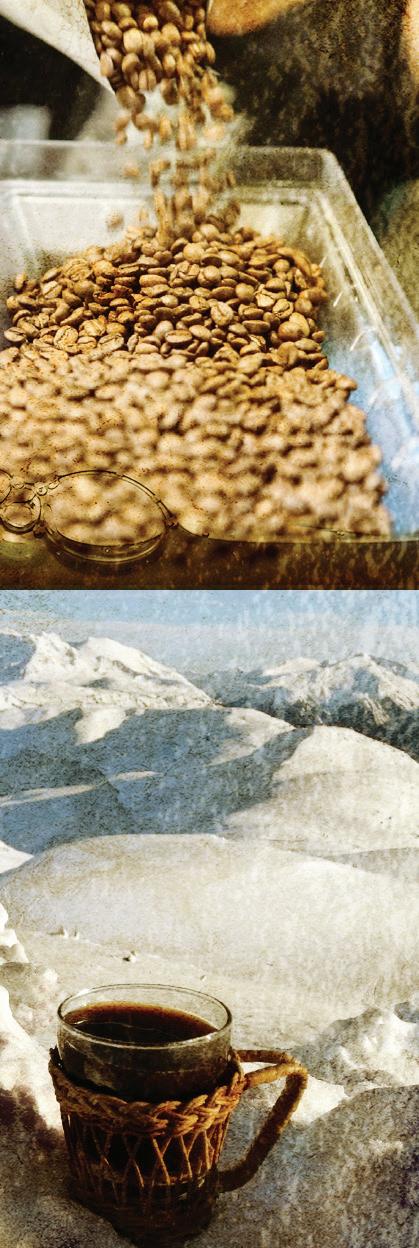
According to the British Coffee Association, humanity consumes about 2 billion cups worldwide every day. Just like many other forms of modern consumerism, coffee production and consumption have had to attune to the climate crisis at hand. Arabica—the world’s favourite coffee plant variety, as an essentially cool, flowering plant—is currently suffering under today’s accelerated climate change. And so, as we approach the middle of the century, world coffee specialists are looking into alternative coffee plant species that can withstand higher temperatures and lower rainfall, but also still provide the consumer the
experience they expect from coffee. This balance between climate consciousness and consumer satisfaction is what many Whistler and wider B.C. coffee roasters are trying to execute, including Tyler McNeil, local owner and roaster at Slopeside Coffee Roasting Company.
Under a rain-drenched marquee set up at the Whistler Farmers’ Market, McNeil explains how he works to form a reciprocal relationship when it comes to coffee—roasting to order in small batches to harmoniously reduce waste and allow for prime freshness. “I sell my coffee online and do free delivery within Whistler. Sometimes it takes a few extra days because I want it to be fresh as possible,” he says. Unlike most coffee roasting machines that require gas or propane, McNeil uses a fluid bed roasting process that requires only electricity and air to roast the coffee. “The roaster I use is electric—which in British Columbia, is almost entirely renewable,” he says.
With the third-wave coffee evolution bringing swells of execution and sourcing transparency, the modern world of craft coffee requires a certain level of camaraderie between growers, producers, and consumers. Right now, McNeil works with an importer down in Delta, where they manage the sourcing of the beans. “In terms of sourcing, ideally the best way to get ethical beans is to order directly from the farmers. But being so small I just can’t do that yet,” McNeil explains. “Eventually, I would love to get to a level where I can go straight to the farm, meet the farmers, see their farming practices and develop a oneon-one relationship.”
McNeil had a humble coffee upbringing, specialty coffee being something he has only gotten into in the past four years. “Coming from a small town in Ontario, you either had Tim Hortons or McDonald’s,” he explains. “So when I went to Australia, I remember they asked me what kind of coffee I wanted… and I was like, ‘Oh, there are different types of coffee?’ I didn’t know there was anything more than drip!”
McNeil was impressed by the Australian coffee culture, and felt as though that culture was slowly starting to pick up back home. When asked what coffee represents to him here in Whistler, McNeil paints a rather encapsulated picture: “I imagine it being 5:30 a.m. on a cold powder day… you go get a hot coffee and wait in line for two
hours to get fresh tracks.”

Unfortunately, the business matrix for many Whistler coffee crafters appears to operate on the common basis of conflict; the fight against big investors coming in and buying up real estate to create more homogenous hospitality. Due to not being able to find an affordable place to roast here in Whistler, McNeil continues to roast out of a communal kitchen in Squamish. “It is a lot of driving… but I make the most of the space and time. I drive down to Squamish and I roast till I pass out,” he says.
After these open-ended discussions with Whistler’s local coffee connoisseurs, it appeared that the unique operating environment here in Whistler meant the navigation of common coffee barriers—affordability, transiency, and a decent space to operate. As Whistler remains an abundant outdoor enterprise; a place where everyone has a PhD in adventure and activities, it renders an enigmatic coffee culture. But despite its grandiosity, it is these local coffee vanguards—roasters, baristas, and shop owners—who remind us that it is the smaller-scale mechanisms that give Whistler its livelihood.
Evidentially, the variables that constitute a great cup of coffee are endless. Although a small measurement of liquid, a cup of coffee requires a massive amount of global, domestic, and community-based coordination. This community-based collaboration is what is set to help Whistler nourish a much more vibrant coffee culture—one in which the glass is always half full!
Whether a destination or a vacation, Whistler will always be a place of inherent connection. Coffee, alongside it, will always be a form of communion and togetherness. As winter is upon us, it is the time to come together over coffee, to pause in between life’s constant doings and relish in nature’s surroundings.
As Mahmoud Darwish puts into poetry: “Coffee is the morning silence, early and unhurried, the only silence in which you can be at peace with self and things… therefore, coffee is the public reading of the open book of the soul. And it is the enchantress that reveals whatever secrets the day will bring.” n
AFTER THREE LONG years away from competition, Thunderbird Corner is roaring again and a pair of young Sea to Sky athletes find themselves right in the mix.
Whistler’s own Tirza Lara and Payton Spence of Squamish are members of Bobsleigh Canada Skeleton’s NextGen team. Both saw action Nov. 11 and 12 in the IBSF North American Cup at the Whistler Sliding Centre. Lara, 21, grabbed a pair of top-10 finishes, while Spence, 15, placed 11th on consecutive days in her very first international event.

Two-time Canadian Olympian Mirela Rahneva envisions a bright future for them both.
“[I’ve seen] a lot of talent, a lot of potential and a lot of growth over the past couple of years,” Rahneva said of her young compatriots. “Tirza and Payton have moved up quickly. It’s exciting to see. It goes to show that when you have the facility, it will attract local talent, and I would hope that more comes out of Whistler.”
The Whistler Sliding Centre boasts the fastest track of its kind on Earth, with skeleton sleds reaching up to 146 kilometres
an hour down 1,700 metres of curated ice. It’s all over in less than a minute. Young athletes must prove themselves ready for that kind of speed: they begin from the junior start point down at Corner 6 and progress to Corner 3 (called the Wedge) to gain experience before launching themselves from the main starting zone atop the track.
“Making your way up to the start is really a big milestone for any slider,”
Skeleton was not Lara’s first love. The former Calgarian began dancing at age four, and by 15 she was a dedicated ballerina. After performing with the Mexican National Ballet, Lara aspired to join a dance company in Vancouver, but knee injuries forced her to find a new path. Her younger brother ended up helping.
Olympic alternate Cassie Hawrysh. By her second run, Lara was in love.
“The world around me kind of, like, shut off,” she recalled. “And it was just me, the ice, the speed and nothing else. It just got faster and faster and faster, it built up to this huge crescendo through Corner 16, and then as soon as I came out, that was when that adrenaline hit. And I was addicted to that feeling.”
Lara was all in. In June 2018, after finishing her Grade 11 classes, she moved to Whistler as a 16-year-old with a summer job at the Sliding Centre. The ordeal of balancing work with her final year of high school and training in her new sport—not to mention navigating local public transit— taught Lara the importance of reaching out to people and finding connections wherever she can.
Rahneva explained.
Down at the bottom, after a technical stretch known as the Gold Rush Trail, waits Thunderbird Corner. Many tracks have their own distinctive features, and the 16th corner in Whistler (named in honour of local First Nations culture) is notorious for its speed and technical challenges. The fact that Lara and Spence are already racing the full course on an international stage is no mean feat, with plenty more milestones on the way for both.
Noah Lara is a former youth speed skater, and through watching his races, Tirza became interested in the passion, joy and commitment that comes with participating in Olympic sports. Watching skeleton sleds fly by at Canada Olympic Park in Calgary jogged her memory, and for her 16th birthday, Lara asked her mom to treat her to a public skeleton experience at the Whistler Sliding Centre (something that anyone in good health can sign up for).
Her coach that day was 2014 Canadian
So how did a ballet background translate to skeleton? Better than you might think. Dancers need excellent body awareness, a trait that also serves well when driving a high-velocity sled down a frozen track using subtle movements. Being a ballerina also helped Lara find enjoyment in many hours of practice and physical conditioning as an athlete.
And just like ballet, minor errors can be the difference between success and failure in skeleton. Lara finds that balance in her life is vital to her well-being in a sport where one one-hundredth of a second can keep a competitor from the podium. She remains a student, taking a bachelor’s degree in
“Tirza and Payton have moved up quickly. It’s exciting to see. It goes to show that when you have the facility, it will attract local talent...”
- MIRELA RAHNEVA
human science through Athabasca University. Her mom and brother now live in Sun Peaks, making it a little easier for her to stay in touch with them.
“I was having this conversation with one of our national team girls the other day, to try and make [my goals] more like qualitative versus quantitative, and focused on clock, because to an extent, there is a bit of luck involved,” Lara said. “Focusing instead on the things that I can control has been very useful.”
Spence, as previously mentioned, is 15 years old. Last week, she set a personal best top speed of 133 km/h on a skeleton sled at the North American Cup. The first time I went that fast, I was well into my 20s—and driving a car.
The Squamish native first found sliding at age 13, when she was curiously informed that she was “too old” to pick up luge. Skeleton was next, and its adrenaline rush hooked her much as it did Lara. Due to her youth, Spence began training out of the forgiving “Maple Leaf” start point just before Corner 11 (the same place average citizens launch their public skeleton runs from), working her way up to the top.

These days, Spence is competing against Canadian national team seniors like Jaclyn LaBerge and Olympians from abroad like Anna Fernstadt of the Czech Republic, proving that the spotlight is not too bright for her.
“Oh, it was so much fun,” she said about her first North American Cup experience. “I wish I could do it again sooner.”
Sliding is a family affair in the Spence household. Payton’s older brother, Connor, is a bobsledder, while her younger sister Allie got into luge. The kids often train together and volunteer at the track along with their mom, Stacey,
helping young lugers practice their starts and race officials move around equipment for older athletes.
Spence credits the world of sliding with unifying her and her siblings in pursuit of a common goal.
“Knowing that I can go places in skeleton makes me really want to push myself to go those places,” she said. “And then I know that luge is pushing my sister to go places as well, and bobsled [for my brother].”
Most parents do not have to worry about their children screaming down icy racetracks at breakneck speeds, but that is Stacey Spence’s lot in life. Needless to say, she is proud of her kids and how they celebrate each other in sport and life. Although the Spence matriarch is often far more nervous about her daughter’s races than her daughter is, she credits Whistler’s employees, track workers and coaches for making it inviting to spend long hours at the Sliding Centre.
“Payton’s coaches, Joe Cecchini and Micaela Widmer, have been incredibly supportive and inclusive with her training,” Stacey said. “They treat her like an athlete despite there being an age difference. It makes it easier as a parent to watch [skeleton].
“I get a lot of people who say: oh my God, how do you handle this? And I’m like, you have to see how everybody works around her. I feel completely safe.”
Spence looks forward to getting more races under her belt this year, gaining in both velocity and experience. She hopes to one day forerun (or test the track) at a World Cup event for her mentors on the national team, Rahneva and Jane Channell. She also wants more people to know that her sport is much safer than it may appear.


“Skeleton is actually the safest of the three sliding sports,” Spence said. “It’s actually not as scary as you think.”
Find more info, including full race results, at ibsf.org. n

Please join us for a social night of food and drinks at the Lost Lake Passive House for our Annual General Meeting on Thursday, November 17th at 6:00pm.
Come hear what we’ve been working on and our future plans All Board of Director positions are up for re election and are voluntary If you are interested in joining the Board please email the Administrator in advance and attend the meeting to nominate yourself Please note you must be a current member of Whistler Nordics
Email: admin@whistlernordics com Food and drinks will be provided.
Are you interested in advising RMOW Council on issues related to forestr y, wildfire, wildlife, and commercial and public recreation around Whistler?
Two 3 year term positions are available to ser ve on the Council appointed Forest & Wildland Advisor y Committee You should have a background in forestr y, ecology, and/or resource management, and a k nowledge of the Whistler area The committee m eets once per month for 2 hours during business hours.
Please submit a shor t information sheet describing your qualifications and interest before 4:30 p m , December 1, 2022.
Committee Information: whistler.ca/fwac
Please email applications to lburhenne@whistler.ca

t Municipality of Whistler w h i s t l e r. c a
Apr il 19, 1961 Nov 2, 2022
A Celebration of his Amazing Jour ney
P lease come and join us at the GLC (details below) to celebrate one of W histler, Squamish, Lake L ouise, and hometown Sarnia, Ontario’s favourite people.
L egendar y figure to ever yone that was fortunate enough to know him, Cuz was a fantastic husband to Sawako, an amazing ‘Unc le’ to Isshin, Ryoma, and Yamato (and Family), an absolute Crusher in the sof tball wor ld, owner and Mentor of Spicy Sports, and Bartender extraordinaire back in the day at Buffalo Bills
Cuz was a true music lover and he and Sassy travelled ever ywhere to enjoy live music. L ooking for ward to sharing stories and myths with all of Cuz’s people
Fr iday 25th November at GLC, 8pm 12 19+ event
Your Hear t and S oul and Fr iendship will be with us all together.
SIX MONTHS AFTER winning the BC Rugby Men’s Division 2 Provincial Championship, the Axemen Rugby Club has broken new ground once more.
Club standouts Blake Mahovic and Josh Michalik were selected to join the Canadian National Men’s Rugby League team for an international match on Nov. 5 against the USA Hawks. The Canada Wolverines prevailed 22-10 against their American rivals in Tampa, Fla., making a goal-line stand in the final 10 minutes to preserve the win.
First-year Axemen head coach Stephen List is ecstatic that two of his players got to wear the Maple Leaf.
“I’m exceptionally proud,” List said. “For [Mahovic and Michalik] to represent their country is no mean feat. It’s something that we should all celebrate.”
The achievement is doubly impressive because Mahovic and Michalik had to adapt to a different code (or style) of rugby. The Axemen, who represent Whistler, Squamish and Pemberton, play rugby union, which differs from rugby league in that it has 15 players per side and more stoppages of play. Many well-known Canadian rugby athletes like Al Charron, Nathan Hirayama and Jen Kish played union during their careers.
In comparison, rugby league features only 13 players per side, fewer stoppages and a limit of six tackles per offensive attempt. Get tackled six straight times without scoring a try and you turn the ball over to your opponent. Rugby league features different tactics from union, and is more demanding in terms of cardiovascular fitness—which Mahovic and Michalik successfully acclimated to.
The two national team debutants have walked different paths to reach this point. Mahovic hails from the north of England, where he originally played rugby league before picking up union in Canada with organizations like BC Rugby, the Canadian Classics and the Axemen. Meanwhile, Michalik is from Ontario, and was introduced to rugby league last year by Blake Stewart, head coach of the Whistler Wolves.
Mahovic is known as a well-rounded inside centre, both a tenacious defender and an elusive attacking threat who consistently puts up big scoring numbers. Yet his impact off the pitch may be even greater. The Englishman has served for three years as Director of Rugby for his club and is a lead defensive coach on Thursday nights. Furthermore, List
credits Mahovic for “living and breathing” the culture of community and inclusion that the Axemen strive to build.
If you ask List, he will say that Michalik, meanwhile, is a much-improved athlete who was honoured with the club’s own Players’ Player of the Year award in May. An outside centre, Michalik runs with blistering pace and is particularly adept at exploiting gaps in the opposing defence. Off the pitch, Michalik is known as an energetic social dynamo who helps organize post-match entertainment at local venues like The Fitzsimmons Pub in the Upper Village (which also sponsors the team).
Mahovic and Michalik’s recent achievements parallel the continued rise of their club as a whole. After claiming the Division 2 title 30-15 over the Surrey Beavers on May 7, the Axemen declared to move up into BC Rugby’s Division 1. So far, they hold a 3-5 record against highlevel opponents from across the Lower Mainland. The climb in competition naturally presents hurdles, as does an increased commitment to travel for away games in places like Kamloops, Kelowna and Vancouver Island.
But these are obstacles that the Axemen relish.
“They’re good challenges when it comes to the competition,” List said. “They’re challenges that we want, that we as a club will grow from.”
Established in its current form in 2014, the Axemen were once a Division 3 team that steadily built momentum on and off the pitch. Today, they field rosters in both Divisions 1 and 3, which allows them to welcome both high-level athletes and recreational players or those new to rugby. Committed to reaching the next generation, the Axemen also offer a women’s team and a vibrant youth rugby program in Squamish.
Moreover, the club received a grant from the Resort Municipality of Whistler at the beginning of this academic calendar to support rugby at Whistler Secondary School. Axemen coaches helped establish a rugby program for youngsters in Grades 8 and 9, which culminated in a competitive game against St. George’s Senior School in Vancouver.
“We’re not expecting [youths] to just find us, but we’re actually getting into schools and introducing rugby as well,” said List. “If we’re a community club, then we want to accommodate all areas of the community, so having something for the women, the youth, etc., to flow through is essential. That’s how we view success, really.” n
Cuz, We love you Brother!







old legacy is more than that of a raucous, champagne-and-vodka-fuelled celebration. Over the past 11 years, the event has successfully raised tens of thousands of dollars annually for a wide range of good causes.
IN A TOWN known for throwing a good party, one of Whistler’s favourite bashes of them all is set to return Sunday.
The Bearfoot Bistro’s World Oyster Invitational is poised to welcome about 650 revellers back to the Whistler Conference Centre’s Grand Foyer on Sunday, Nov. 20 for its 10th edition; 11 years after the restaurant hosted the first iteration in its Whistler Village dining room (subtracting one year for the COVID-19 pandemic, of course).
The annual throwdown—known colloquially to many Whistler locals as Oysterfest—has shifted in a few ways over the years: first across the street to the Whistler Golf Club’s practice range, then, eventually, across the Village Stroll to the Conference Centre where it was held as part of Cornucopia for the first time in 2015.
Since then, the event has served as the glamorous culmination to the resort’s annual celebration of all things food and drink, wrapping up the festival on its final Sunday.
But the Oyster Invitational’s now decade-
Net proceeds from this year’s event will benefit Myeloma Canada, a non-profit organization dedicated to supporting those affected by the second most common type of blood cancer.
For event organizer and 10-time national oyster-shucking champ Eamon Clark, the Bearfoot’s emphasis on working with charities is something he’s long admired.
“It’s their No. 1 focus,” he said. “Yes, there is an oyster competition, and they leave that up to me to wrangle, but they’re always concerned about how much money they can raise. It’s their main concern. They just want to give back and this is a great opportunity to do so—and the oyster shucking competition provides some pretty unique entertainment.”
The event has invited about 20 “of the top oyster shuckers from different parts of the world” this year, explained Bearfoot Bistro’s marketing and communications director Marc Des Rosiers, adding, “It’s quite a serious competition.”
Attendees will be treated to a frontrow seat to watch champion shuckers like Honor Allen (the fastest shucker in the U.S., competing for the first time in Whistler), Irish national champ David Small, and reigning winner Mike Osborne, from right here in B.C., aim to shuck as quickly as
possible while “maintaining the integrity of the oysters,” explained Clark. There’s money on the line too, with a $5,000 prize set aside for the winner, and smaller purses for the two other podium finishers.
As Clark explained, the entertainment isn’t the only unique aspect of the Sunday afternoon shucking competition.
“They don’t do this anywhere else in the world where they use three different species of oysters,” he explained. In addition to opening up the meatier Pacific, or Gigas, oysters typically found in B.C. waters, shuckers will also be tasked with handling Eastern, or Virginica, oysters from the Atlantic, and European Flat oysters harvested in Ireland.
Among the pacific oysters set to be shucked Sunday are 750 dozen molluscs (roughly $7,000 worth) donated by presenting sponsor Sawmill Bay Shellfish Co., in addition to a sizeable cash donation. The family-owned Sawmill Bay has supported the event right from the outset.
When longtime customer Bearfoot initially proposed the idea of a shucking competition in 2011, “The first year was a little bit of an unknown, so we took the risk and said, ‘Yeah, let’s try and do this.’ And then we’ve done it ever since,” said owner Steve Pocock, over the phone from his Quadra Island home.
“We get a real kick out of serving the oysters to the general public and getting good feedback and appreciation,” he added. “It’s just an awesome event.”
Not a fan of oysters? Both Pocock and Clark offered a few tips for the shellfishaverse: talk to the person serving your oysters, start small, and make sure to top your oyster with garlic butter, chili sauce or other acidic-forward toppings to offset the salty, briny flavour.
If that still isn’t enough to make oysters sound appetizing, Clark shared one piece of information that might prompt you to look at the molluscs in a different light: After indulging in a few oysters before a night out, “I always feel so much better the next day, even if I had a bunch of drinks, because there’s so many nutrients in oysters,” he said with a laugh, “It helps you recover.”
If all else fails, Bearfoot’s illustrious executive chef Melissa Craig is preparing a massive array of offerings designed for every palate, from caviar and foie gras to charcuterie and dessert and more, explained Des Rosiers, while numerous wineries and breweries will also be on deck.
For Clamato fans, the Bloody Caesar Battle is back, too. Seven B.C. bartenders, each sponsored by a different spirit brand, will be challenged to create their own unique take on the bloody Caesar using their respective spirit, and serve them up to a judging panel tasked with selecting the winner.
The Bearfoot Bistro’s 2022 World Oyster Invitational and Bloody Caesar Battle takes place at the Whistler Conference Centre on Sunday, Nov. 20 from 3 to 7 p.m. Tickets are $159 and available at showpass.com/ oyster2022. n
 SHUCK OFF The Bearfoot Bistro’s World Oyster Invitational shucking competition and Bloody Caesar Battle will celebrate its 10th anniversary and the closing of another Cornucopia when it returns to the Whistler Conference Centre on Sunday, Nov. 20.
SHUCK OFF The Bearfoot Bistro’s World Oyster Invitational shucking competition and Bloody Caesar Battle will celebrate its 10th anniversary and the closing of another Cornucopia when it returns to the Whistler Conference Centre on Sunday, Nov. 20.
Carmen I Gentle Fit 1-2
I TRX Mixer 5:15-6 p.m. Courtney












6-7 p.m. Courtney

R REGISTERED FITNESS Registered fitness

Pre-registration



I Mountain Ready 5:30–6:30 p.m. Anna

I
Yoga
I
Release 8-9 p.m. Laura I Slow Flow Yoga 8 9 p.m. Laura F
HINDSIGHT, THEY SAY , is 20/20.
For Jesse Arthur Carroll, who has worked as a stand-up comedian, voice-over actor, and screen actor, that’s meant he can connect the dots between his years in Whistler to his current life in New York City.
If you lived in the resort from 2011 to 2014, you might remember him from Maxx Fish, where he was manager and ran a comedy night.
“Honestly, I look back at that time with such fondness,” he says. “I partied like I was on tour with Mötley Crüe—I was running a nightclub, but I don’t know if I’d be here if I didn’t do that. When I was running those comedy nights, I had all these Aussies coming up to me saying, ‘You’d kill in Australia. You’ve got to come’ … [Performing in Australia] eventually brought me back to Vancouver to get back into acting. It was the start of the long journey to get me to New York.”
You could follow any one of those interesting threads to learn more about Carroll’s compelling career, but one that people love to ask about is voice-over work.
It all started as he entered his late 30s
and realized his nightclub-running days might not last forever.
“It’s hard to sustain when you get to be an old guy like me,” he says.
With some acting experience under his belt, he happened upon an instructional YouTube video about “how to get voiceover work from home” and looked into it. Intrigued, he went all in, purchasing highend recording equipment and teaching himself both how to use it and how to edit.
After finding success in that niche acting realm, Carroll realized he wanted to get back into acting on screen—for which he had gone to school in Vancouver in the mid-2000s.
“In order to get to the level of acting I wanted to, I knew I needed to go down to America. That’s what made me want to make the transition,” he says.
While he got his American work visa
Hallmark movies and The Imperfects, streaming on Netflix, he is also starring in a short film making its Canadian debut at the Whistler Film Festival on Dec. 4.
Smoke Eater, set in 1981, chronicles the day of a young girl who shadows her mom as the only female firefighter on the force.

Carroll plays Kurt, a firefighter who appears to be a good guy on the surface, but takes a less likeable turn.
“It was shot in Langley in two different fire departments,” he says. “It was neat because the firemen were actually there and there were a couple of calls while we were there … They’re serious. I talked to one of the guys when they were hanging out between shots and as soon as that alarm went off, they were gone.”
Working with Kaylah Zander (who plays the main character), her on-screen daughter Maria Frazer, and director Gloria Mercer was a highlight, he says.
“The first month I made maybe $50 to $100,” he says.
But then he signed up for various audition websites and began applying for every voice-over gig he could find.
“I did 20 to 30 auditions a day,” he adds. “That made me so much better. It took about 200 auditions or so, but then [the gigs] started to roll in after that.”
These days, you can find his voice on more than 500 different credits, everywhere from advertisements for Nintendo, Amazon, Walmart and Toyota, to the narrator of the
through an audio post-production studio and continues to work in that realm, he also started studying acting at New York’s Terry Knickerbocker Studio, where everyone from Sam Rockwell to Natasha Lyonne and Emmy Rossum have all been coached.
“He was the top coach in the business,” Carroll adds.
While you can find Carroll’s acting chops on display in a range of places—including streaming Christmas movies this season like Mingle all the Way, Christmas Pen Pals, and Christmas on Holly Lane, as well as several
“They were so collaborative and open to ideas,” he says. “They had their own vision, but they were accepting of mine … I didn’t want to play Kurt like he was a villain, which he is, but that was too obvious. I thought it was more true to reality that he didn’t think he was doing anything wrong.”
Catch Smoke Eater at the Whistler Film Festival on Sunday, Dec. 4 at 1 p.m. at the Maury Young Arts Centre.
The festival runs in-person from Nov. 30 to Dec. 4 and online until Jan. 2. For more information or tickets, visit whistlerfilmfestival.com. n
“In order to get to the level of acting I wanted to, I knew I needed to go down to America.”
- JESSE ARTHUR CARROLL



 BY ALYSSA NOEL
BY ALYSSA NOEL
IT WAS A TOUGH blow for musicians like C.R. Avery when CD sales at concerts started to tank.
But, taking a page from director Quentin Tarantino’s book, the Vancouverbased multidisciplinary musician and artist is not complaining about new technology displacing old. Rather, he’s adjusting.
“I saw [an interview] where Tarantino was talking … about streaming services,” Avery says. “Tarantino was like, ‘Stop complaining. That’s how the world is and you’ve got to give people the excuse and reason to see [movies] on the big screen.’”







So that’s exactly what Avery did with his new feature film/live show mash-up.


Victory on East Hastings begins with a ballet company based in Galway, Ireland in the ’80s performing a politically charged piece. When authorities try to shut down the performance, riots break out, killing two theatre ushers in the process, and causing the show to get banned.
Fast-forward to present-day East Vancouver. A burlesque group receives an anonymous package pitching that same show, complete with notes on choreography and cast. Taking the enclosed note of encouragement to heart, they decide to

“It was amazing,” he says of those first shows. “But I was like, COVID is over, let’s go.”




He parsed down the talent for the tour and, ultimately, chose four cast members to hit the road, stopping in small-butpicturesque places like Lasqueti Island, Cumberland, and, on Nov. 19, Whistler.
“In some ways, some things worked better slightly smaller and other things didn’t,” he says. “By the time I get to Whistler I’ll have done six shows. Each one, you tighten the screws up a bit and move things around.”
In the end, the show is meant to serve as Avery’s love letter to East Vancouver, which, pre-COVID, he thought he might leave.
mount the performance, even though they’re not a ballet company. During the show, the ghosts of the ushers appear and help them through.




But that’s just the on-screen plot. The show itself cuts seamlessly between the screen and live performances, including parts of the score.
“Sometimes the movie stops and there’s a poof of smoke and it’s starting again. Then it’s two minutes live and two minutes on film,” Avery says.
He spent the last two years putting the production together and, initially, staged it in Vancouver and Winnipeg with a live orchestra.
“East Van was my neighbourhood and where I got inspired and where I raised a family,” he says. “When I didn’t have that chain anymore, I thought, ‘Maybe it’s time to go to one of those cities I love that I visit on tour’—the island or Berlin or Brooklyn … I wanted to say I love you before I left.”
The move was meant to happen after Victory on East Hastings’ year-long tour, but then the lockdown hit and the future, of course, remains to be seen.
One thing, though, is certain: Avery has heeded Tarantino’s advice and created the film you can’t simply see from your couch.
“I’m just like, ‘This is the reason I’m going to kick streaming’s ass, because you have to see the show live,” Avery says. “When is the movie coming to [your] town? When I come!”
Check it out at The Point Artist-Run Centre on Saturday, Nov. 19 at 7 p.m. Tickets are $25 at thepointartists.com/events.html. n
“This is the reason I’m going to kick streaming’s ass, because you have to see the show live.”
- C.R. AVERYMOVIE MAGIC C.R. Avery is bringing his Victory on East Hastings tour to Whistler to The Point Artist-Run Centre on Nov. 19.
Photo Exhibit on November 18! Admission is free, just show up and enjoy with us alongside appies, live music and drinks.
> Maury Young Arts Centre
> Friday, Nov. 18, 7 p.m.



Join Arts Whistler every week in November for a series of fun Indigenous-led workshops at the Maury Young Arts Centre. Don’t miss this weekly opportunity to build stronger relationships, share in Indigenous knowledge, and foster greater understanding.







> Events scheduled for Nov. 10, 17 and 25. Prices, venues and start times vary







> Head to artswhistler.com/emham for tickets and more info.
A brand-new market hosted by your local artists featuring creatives from the Sea to Sky and across B.C. This two-day event will feature up to 40 vendors in Whistler’s biggest indoor market since 2019.

> Fairmont Chateau Whistler, Frontenac Foyer and Ballroom
> Nov. 26, 11 a.m. to 6 p.m. Nov. 27, 11 a.m. to 5 p.m.
> Entry by can or coin donation to Whistler Community Services Society

IF THE MORE THAN 100 submissions to the We Are AWARE: Nature Photo Exhibit are any indication, local photographers have their lenses pointed in a variety of directions.
“We got a huge range,” says Claire Ruddy, executive director of the Association of Whistler Area Residents for the Environment (AWARE). “Everything from wildlife pictures—taken from a safe distance—to landscape shots to pictures with people paying attention to the small things around them like mushrooms and fungus.”
An equally diverse jury of biologists and photographers whittled down those entries—which could be from any time, but had to be within 75 kilometres of Whistler— down to more than 60. Those images are now on display at The Gallery at The Maury Young Arts Centre until Dec. 23.
While there were some photographers who self-identified as professional in their submissions, the majority are amateurs and mostly from around Whistler.

“We’ve got a couple of uniquely appreciated images that are getting prizes—either because of what’s contained in the picture [or] how it stands out to local
biologists and scientists on the panel—and then also ones that were voted top three by photographers,” Ruddy says.
The exhibit will kick off with a free art party on Friday, Nov. 18—open to the public— with appetizers, live music, and drinks.
The photos, which will all be for sale,

are also accompanied by information on eco-stewardship, in keeping with AWARE’s mission.
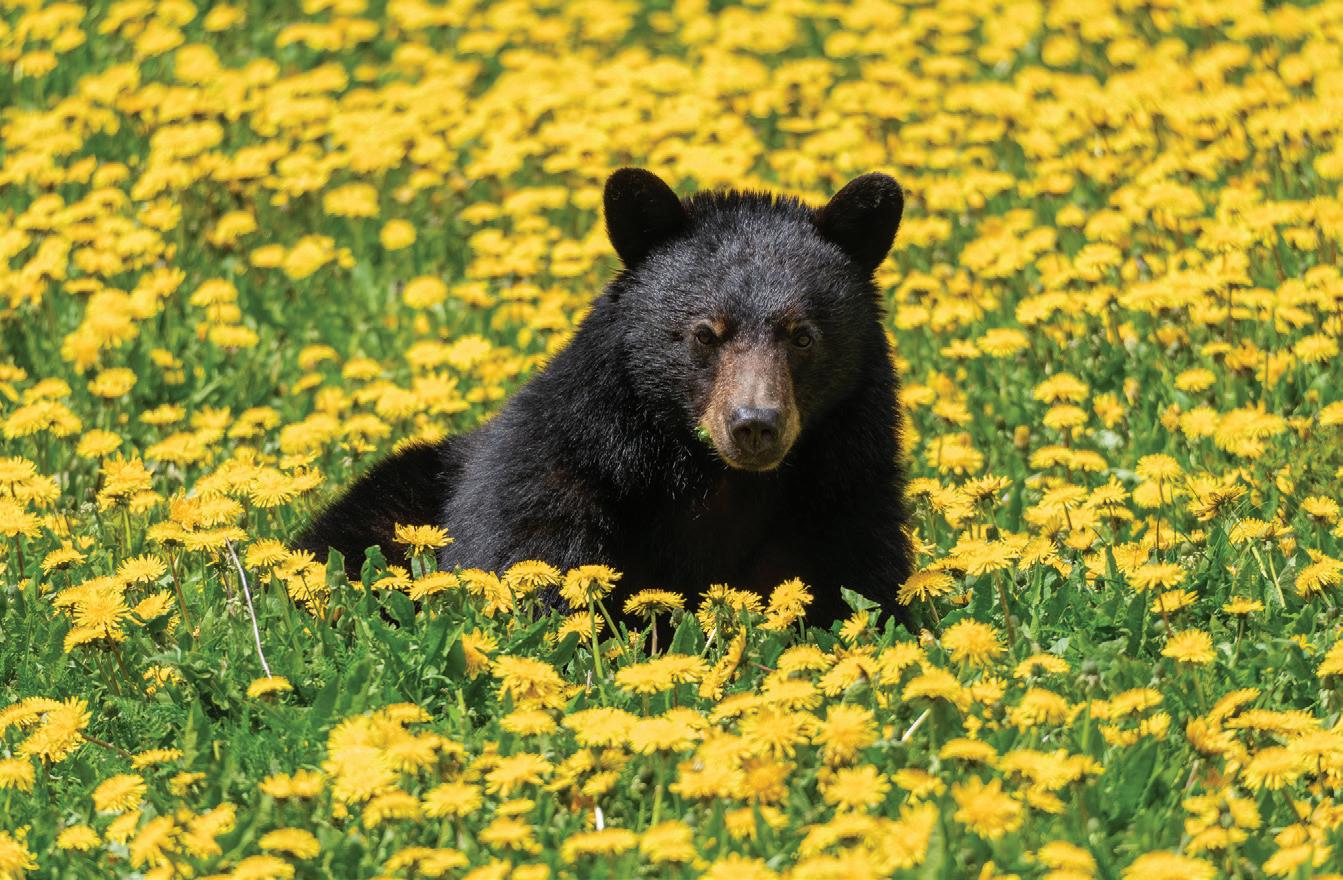
“It’s a chance for people to see the amazing images, but also think about the steps for taking care of nature and broader issues like climate change,” Ruddy says.
“And it’s an awesome opportunity for people to pick up gifts inspired by nature.”
AWARE had started talks with Arts Whistler pre-COVID about combining nature and art for a project.
“Nature and humanity are so intertwined, and art is one of the unique human ways to celebrate that connection,” Ruddy adds. “On our end, we know when people love something they’ll do more to protect it. The synergy between art and nature has always been obvious. It’s just about finding the right project.”
If you missed out on submitting this year, don’t worry. With so much interest, Ruddy said it’s possible the contest could return.
“It’s been really good to get the volume of submissions we got this year,” she says. “We would love to look at ways to make this an annual event, but think about ways to keep it fresh. We see a ton of value in spreading this message of ‘Take only photos and leave only footprints.’ The thing with messages is they often need to be repeated.”
We Are AWARE: Nature Photo Exhibit runs until Dec. 23 at the Maury Young Arts Centre. Catch the opening party on Nov. 18 from 7 to 9 p.m. For more information or to RSVP, search “We Are Aware: Nature Photo Exhibit Art Party” on Facebook. n
 BY ALLYN PRINGLE
BY ALLYN PRINGLE
THERE ARE MANY options when it comes to holiday shopping in Whistler and, for many, craft fairs and markets are looked forward to as an opportunity to find something unique and support local artists. For many years, the best-known craft market in Whistler was the Bizarre Bazaar.

Ten years before the first Bizarre Bazaar was organized by the Whistler Community Arts Council (now called Arts Whistler) in 1987, the Alta Lake Community Club (ALCC) began hosting its annual Fall Fair fundraiser, where local artists could sell handmade crafts. The first Fall Fair in 1977 was held in the gym of Myrtle Philip School, and was so successful that it made a profit in its first year. By 1985, the Fall Fair had grown large enough that it moved into the recently opened Conference Centre.
Like the Fall Fair, the Bizarre Bazaar began in the Myrtle Philip School gym as a fundraiser, this one to support the Whistler Children’s Art Festival. At the time, the Arts Council was still young (Arts Whistler celebrated its 40th year of operations this year), had no office space, and was run by a group of dedicated and hands-on board members and volunteers, including Gail Rybar, who coordinated the first Bizarre Bazaar in 1987.

Held on Dec. 5, 1987, the first Bizarre Bazaar included sales of local arts, crafts and food, a raffle, live entertainment from flautist Dorothy Halton and Celtic harpist Theodore Gabriel, lunch and dinner, a “beverage garden,” children’s craft workshops with Pene Domries, and photos with Santa. Like the Fall Fair of the ALCC, the first year of the Bizarre Bazaar was reportedly a success, and raised enough money to fund the Children’s Art Festival in 1988. According to longtime board member Joan Richoz, however, the first year was not without its challenges.
Looking back over 25 years of Bizarre Bazaars in 2013, Richoz recalled that the


volunteer organizers had to put long hours and a lot of effort into the first market. They had borrowed tables from the Delta Mountain Inn (now the Hilton) and, though the hotel was located not far from the school, had to transport the tables over snowbanks. A heavy snow on Dec. 4 meant that some vendors from outside of Whistler were not able to attend, while others left the market early in order to make it home. Volunteers set up stalls and workshops and even made chili so that everyone working the market would have dinner to eat.
In the following years, the Bizarre Bazaar grew, and also came to include a bake sale fundraiser for the Whistler Museum and Archives Society. Museum volunteers including Florence Petersen, Joan Deeks, Lil Goldsmid, Isobel MacLaurin, Kathy Macalister, Shirley Langtry, Viv Jennings, Darlyne Christian and more would spend weeks ahead of the market baking in order to raise money for the organization. Other community groups also got involved, with the Girl Guides running activities, the Whistler Community Services Society operating the food concession, the Whistler Public Library selling tickets to its own annual fundraiser, and both the Whistler Singers and the Whistler Children’s Chorus performing seasonal numbers.
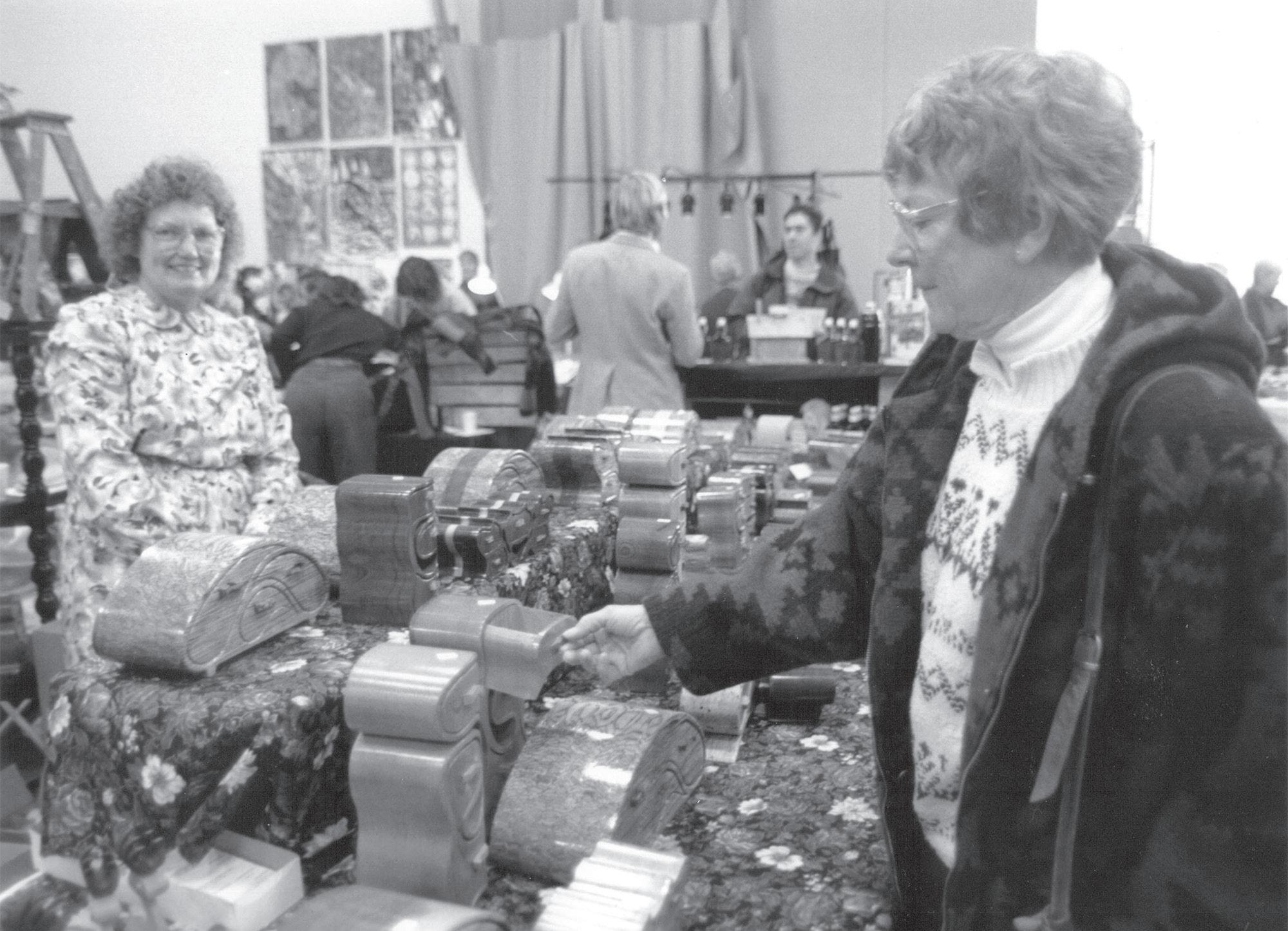

When a new Myrtle Philip Community School opened on Lorimer Road in 1992, the Bizarre Bazaar moved with it, and continued to run out of the school gym until 1996, when it moved into the Conference Centre. In the 2000s, the market continued to expand and change, moving to a weekend in November, partnering with Bratz Biz (a youth artisan market for local young entrepreneurs) in 2006, occasionally switching locations to the Westin Resort, and changing its name to the Arts Whistler Holiday Market.
This winter, though there is no Bizarre Bazaar or Arts Whistler Holiday Market, Bratz Biz and the Whistler Artisan Market will take place in the Upper Village on Nov. 26 and 27. If you’re in search of archival images of Whistler, we will be at the Whistler Artisan Market








Chief Operator Wastewater Treatment Facility
Regular Full Time
Truck Driver Class 3 Night Shift Temporar y Full Time
Recreation Program Leader Temporar y Par t Time (20 30 hours)
Executive Assistant to the Chief Administrative Officer
Regular Full Time
Recreation Facility Attendant 1 Regular Par t Time (20 hours)
Labourer 2 Roads and Parks Regular Full Time
Recreation Program Leader Regular Par t Time (4 19 hours)
Assistant Chief Operator Wastewa ter Treatment
Regular Full Time Recreation Facility Clerk Temporar y Par t Time (parental leave)
IT Senior Systems Specialist Regular Full Time
Manager of Procurement Regular Full Time
Recreation Facility Attendant 2 Regular Par t Time
IT Systems Specialist Regular Full Time
Financial Ser vices Specialist Temporar y Full Time
Truck Driver Class 1 Regular Full Time Utilities Technician Regular Full Time Custodians Casual/ On Call
ARIES (March 21-April 19): Virginia Woolf wrote a passage that I suspect will apply to you in the coming weeks. She said, “There is no denying the wild horse in us. To gallop intemperately; fall on the sand tired out; to feel the earth spin; to have—positively—a rush of friendship for stones and grasses—there is no getting over the fact that this desire seizes us.” Here’s my question for you, Aries: How will you harness your wild horse energy? I’m hoping that the self-possessed human in you will take command of the horse and direct it to serve you and yours with constructive actions. It’s fine to indulge in some intemperate galloping, too. But I’ll be rooting for a lot of temperate and disciplined galloping.
TAURUS (April 20-May 20): “The failure of love might account for most of the suffering in the world,” writes poet Marie Howe. I agree with that statement. Many of us have had painful episodes revolving around people who no longer love us and people whose lack of love for us makes us feel hurt. That’s the bad news, Taurus. The good news is that you now have more power than usual to heal the failures of love you have endured in the past. You also have an expanded capacity to heal others who have suffered from the failures of love. I hope you will be generous in your ministrations!
GEMINI (May 21-June 20): Many Geminis tell me they are often partly awake as they sleep. In their dreams, they might work overtime trying to solve waking-life problems. Or they may lie in bed in the dark contemplating intricate ideas that fascinate them, or perhaps ruminating on the plot developments unfolding in a book they’ve been reading or a TV show they’ve been bingeing. If you are prone to such behaviour, I will ask you to minimize it for a while. In my view, you need to relax your mind extra deeply and allow it to play luxuriously with non-utilitarian fantasies and dreams. You have a sacred duty to yourself to explore mysterious and stirring feelings that bypass rational thought.
CANCER (June 21-July 22): Here are my two key messages for you: 1. Remember where you hide important stuff. 2. Remember that you have indeed hidden some important stuff. Got that? Please note that I am not questioning your urge to lock away a secret or two. I am not criticizing you for wanting to store a treasure that you are not yet ready to use or reveal. It’s completely understandable if you want to keep a part of your inner world off-limits to certain people for the time being. But as you engage in any or all of these actions, make sure you don’t lose touch with your valuables. And don’t forget why you are stashing them.
BY ROB BREZSNYminority of my total emotional range. As an antidote, I proactively seek experiences that rouse my wonder and sublimity and holiness. In the next two weeks, Libra, I invite you to cultivate a focus like mine. It’s high time for a phase of minimal anger and loathing—and maximum reverence and awe.
SCORPIO (Oct. 23-Nov. 21): Scorpio author Sylvia Plath had a disturbing, melodramatic relationship with romance. In one of her short stories, for example, she has a woman character say, “His love is the twenty-story leap, the rope at the throat, the knife at the heart.” I urge you to avoid contact with people who think and feel like that—as glamorous as they might seem. In my view, your romantic destiny in the coming months can and should be uplifting, exciting in healthy ways, and conducive to your well-being. There’s no need to link yourself with shadowy renegades when there will be plenty of radiant helpers available.
SAGITTARIUS (Nov. 22-Dec. 21): I like Sagittarian healer and author Caroline Myss because she’s both spiritual and practical, compassionate and fierce. Here’s a passage from her work that I think will be helpful for you in the coming weeks: “Get bored with your past. It’s over! Forgive yourself for what you think you did or didn’t do, and focus on what you will do, starting now.” To ensure you make the most of her counsel, I’ll add a further insight from author Augusten Burroughs: “You cannot be a prisoner of your past against your will— because you can only live in the past inside your mind.”
CAPRICORN (Dec. 22-Jan. 19): How would you respond if you learned that the $55 T-shirt you’re wearing was made by a Haitian kid who earned 10 cents for her work? Would you stop wearing the shirt? Donate it to a thrift store? Send money to the United Nations agency UNICEF, which works to protect Haitian child labourers? I recommend the latter option. I also suggest you use this as a prompt to engage in leisurely meditations on what you might do to reduce the world’s suffering. It’s an excellent time to stretch your imagination to understand how your personal life is interwoven with the lives of countless others, many of whom you don’t even know. And I hope you will think about how to offer extra healings and blessings not just to your allies, but also to strangers. What’s in it for you? Would this bring any selfish benefits your way? You may be amazed at how it leads you to interesting connections that expand your world.
As the winter season is with us again, we’d like to take this oppor tunity to remind owners, proper ty managers and merchants of the impor tance of keeping walkways, roofs, stairs and landings adjacent to their stores and proper ties free of ice and snow It is essential that customers and guests visiting our Village feel safe and comfor table in being able to travel freely about the area
LEO (July 23-Aug. 22): I know I don’t have to give you lessons in expressing your sensuality. Nor do you need prods and encouragement to do so. As a Leo, you most likely have abundant talent in the epicurean arts. But as you prepare to glide into the lush and lusty heart of the Sensuality Season, it can’t hurt to offer you a pep talk from your fellow Leo bon vivant, James Baldwin. He said: “To be sensual is to respect and rejoice in the force of life, of life itself, and to be present in all that one does, from the effort of loving to the breaking of bread.”
AQUARIUS (Jan. 20-Feb. 18): Aquarian philosopher Alfred North Whitehead wrote, “The silly question is the first intimation of some totally new development.” He also said, “Every really new idea looks crazy at first.” With these thoughts in mind, Aquarius, I will tell you that you are now in the Season of the Silly Question. I invite you to enjoy dreaming up such queries. And as you indulge in that fertile pleasure, include another: Celebrate the Season of Crazy Ideas.
ice and snow It is essential that customers and guests visiting our Village feel safe and comfortable in be ing able to travel freely about the area.
You are required to clear snow and ice from walkways, roofs, stairs and landings adjacent to stores and propertiesby 10 a.m. daily
You are required to clear snow and ice from walkways, roofs, stairs and landings adjacent to stores and proper ties by 10 a.m. daily.
RMOW Property Maintenance Bylaw No 810
RMOW Property Maintenance Bylaw No. 810
Get ready winter by:
Get ready for winter by:
VIRGO (Aug. 23-Sept. 22): Many Virgos are on a lifelong quest to cultivate a knack described by Sigmund Freud: “In the small matters, trust the mind. In the large ones, the heart.” And I suspect you are now at a pivotal point in your efforts to master that wisdom. Important decisions are looming in regards to both small and large matters. I believe you will do the right things as long as you empower your mind to do what it does best and your heart to do what it does best.
Stocking up on ice-melting products (not road salt) and shovels
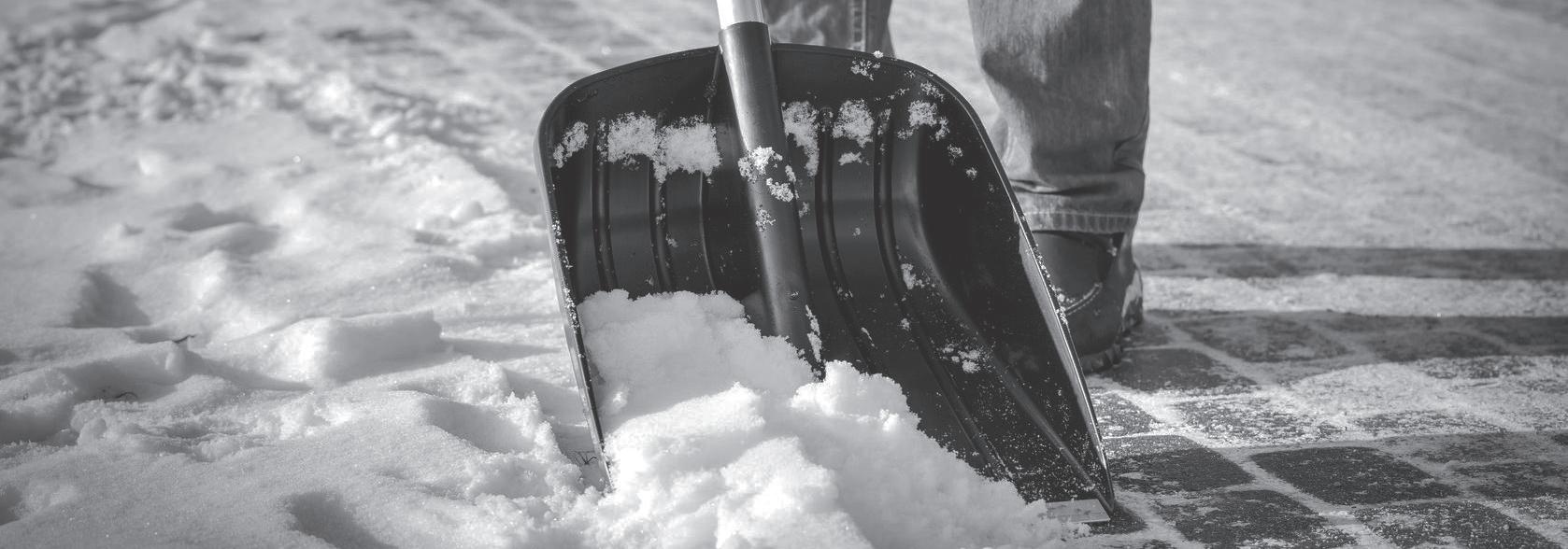
1 Stocking up on ice melting products (not road salt) and shovels
2 Checking the heat tracing on stairs and ramps around your proper ty
2 Checking the heat tracing on stairs and ramps around your property
Thanks in advance for your cooperation.
Thanks in advance for your cooperation
Download the Proper ty Maintenance Bylaw at www whistler.ca /bylaw in the Frequently Requested Bylaws section.
Download the Property Maintenance Bylaw at www whistler ca /bylaw in the Frequently Requested Bylaws section
LIBRA (Sept. 23-Oct. 22): Social media like Facebook and Twitter feed on our outrage. Their algorithms are designed to stir up our disgust and indignation. I confess that I get semi-caught in their trap. I am sometimes seduced by the temptation to feel lots of umbrage and wrath, even though those feelings comprise a small
PISCES (Feb. 19-March 20): We all love to follow stories: the stories we live, the stories that unfold for people we know, and the stories told in movies, TV shows, and books. A disproportionately high percentage of the entertainment industry’s stories are sad or tormented or horrendously painful. They influence us to think such stories are the norm. They tend to darken our view of life. While I would never try to coax you to avoid all those stories, Pisces, I will encourage you to question whether maybe it’s wise to limit how many you absorb. The coming weeks will be an excellent time to explore this possibility. Be willing to say, “These sad, tormented, painful stories are not ones I want to invite into my imagination.” Try this experiment: For the next three weeks, seek out mostly uplifting tales.
Homework: Is there something sad that you could ultimately become grateful for? Newsletter. FreeWillAstrology.com.
In addition to this column, Rob Brezsny creates
In-depth weekly forecasts designed to inspire and uplift you. To buy access, phone 1-888-499-4425. Once you’ve chosen the Block of Time you like, call 1-888-682-8777 to hear Rob’s forecasts. www.freewillastrology.com







JourneymanPlumber AshluMechanicalLtd.IsaPlumbing, HotWaterHeating,andGasFitting CompanythatservesSquamish& Whistler.
Weofferagreatworkenvironment, competitivepay,medical&dentalbenefits,andacompanyvehicle.



Wearelookingforfriendly,motivated, reliableindividualswhopaycloseattentiontodetailandprovidehighqualitywork.Ifyouareexperienced, knowledgeable,canproblemsolve anddiagnoseissuesquicklyandaccuratelywewouldlikeyoutojoinus!
Pleasesendyourresumeto candace.ashlumechanical@gmail.com
NEXII-HIRINGOPENHOUSE
OPENHOUSE-November23rd, 2:00pm-6:00pm
NEXIIisasustainableconstruction technologycompanythatmanufactureshigh-performancebuildingsandiscommittedtodevelopingstrongcareers.
NOWHIRING: WewillbehostinganOpenHouse/ InfoSessiononNovember23rd, 2:00pm-6:00pmforanumberof openopportunities.Allmembersof thecommunityareinvited!

Emailcareers@nexii.comifyou wouldliketoattendsowecan scheduleatouroftheplant.


Full-time,part-time&tempjobs. Nocost,nostrings.604-905-4194 www.whistler-jobs.com















The Vice President of Destination & Market Development provides strategic leadership and direction to promote Whistler as the premier resort destination for leisure and conference business through Conference Sales & Services, Travel Trade, Whistler.com Reservations and Visitor Services. This position also oversees Destination Development, which focuses on the resort experience, and supporting sustainable and responsible tourism events that fill midweek and shoulder-season months.






This is a senior position that requires an individual with developed leadership capabilities, analytical skills, and sales acumen to build strong relationships and drive results. The successful candidate will have strategic aptitude, excellent interpersonal and communication skills, and the ability to manage projects and make sound decisions.
TO VIEW OUR CAREER OPPORTUNITIES, AND TO APPLY, VISIT US ONLINE AT WHISTLER.COM/CAREERS.

































Job ID: #OPH1350
Title: OPERATOR (INDUSTRIAL MECHANIC) – HYDROELECTRIC ENERGY
We are currently hiring the following positions for projects in WHISTLER.
We are currently hiring the following positions for projects in WHISTLER.
Journeymen Carpenters (5+ years)
Journeymen Carpenters (5+ years)
Skilled Labourers
Skilled Labourers
Location: PEMBERTON, BC (CANADA)
Innergex Renewable Energy Inc. is a global player with an extensive and growing portfolio of assets in Canada, the United States, France, and Chile. The Corporation develops, acquires, owns, and operates hydroelectric facilities, wind farms and solar farms exclusively producing renewable energy.

For 30 years, Innergex has believed in a world where abundant renewable energy promotes healthier communities and creates shared prosperity. We are convinced that generating power from renewable sources will lead the way to a better world. Sustainable development generating positive social, environmental, and economic results guides our actions. We are proud not only of the work we do, but also of the way we do it. Our many accomplishments and continued success are made possible by our exceptional team of employees.
Your contribution!
We offer competitive pay, a benefits package, company cell phone plan, interesting projects, a collaborative team environment, and a chance to improve your existing skills.
We offer competitive pay, a benefits package, company cell phone plan, interesting projects, a collaborative team environment, and a chance to improve your existing skills.

We are looking for dedicated team players who want to join a rapidly growing company and establish a long term career in construction.
We are looking for dedicated team players who want to join a rapidly growing company and establish a long-term career in construction.
Please forward your resume to Lea@gccltd.ca
Please forward your resume to Lea@gccltd.ca

$59,878 - $73,564.40
Reporting to the Director of Land & Resources, the On-Reserve Lands Manager is responsible for the management of matters related to land use planning, land registration and natural resource management within all ten of the Lil’wat Nation Reserve Lands. This position will work under ¸approved terms of reference and in accordance with the Lil’wat Land Law Policy and Lil’wat Community Land Use Plan. Responsibilities include managing technical and administrative duties for implementing the Lil’wat Land Law, the Lil’wat Nation Community Land Use Plan, and other policies or initiatives related to land use on Lil’wat Nation Reserve Lands.
Benefits
If you thrive in a fast paced, busy and diverse environment with lots of autonomy then this could be the position for you.
If you like variety in your work experience, are responsible and would like the opportunity to advance your career, Please send your resumé in confidence to: e. info@sparkelectrical.com

Being an Operator – Hydroelectric Energy in Pemberton is to work with the operations team to operate the hydroelectric power plants by way of conducting and documenting all regular monitoring and maintenance. Your experience and your ability to be and work on your own while reporting to a team will make you an ideal candidate.
Your day-to-day!
• Operate the hydroelectric power plants by way of conducting and documenting all regular monitoring and maintenance;
• Carry out all actions required to optimize the output and production of the power plants;
• Participate in the set-up and monitoring of a Preventative Maintenance program for plants’ and facilities’ equipment including their electrical and mechanical testing and repair;
• Perform maintenance, annual maintenance and repair of the power plant;
• Read electrical schematics, wiring diagrams, pneumatic and hydraulic drawings;
• Carry out all necessary actions for the troubleshooting and resolution of alarms generated by the hydroelectric power plants to minimize downtime (availability 24 hours a day) when on duty;
• Manage and/or assist any specialized contractors needed to perform maintenance and repairs at the power plants;
• Participate in the daily work planning and operations activities;
• Adhere to and implement the Occupational Health and Safety standards of WorkSafe BC and Innergex;
• Adhere to a variable work schedule and reside at the Innergex residence while at the facility.
The site and work details:
• This is a remote work site located minutes out of Pemberton (the marshalling point);
• Employees’ work schedule is 8 days on and 6 days off at 10 hours per day for a total of 80 working hours per two (2) week period. Travel time between the marshalling point and the site is included in these hours;
• Employees are provided with a pickup truck for travel between the marshalling point and site and for use on site;
• Employees are required to stay at company-provided accommodations while on shift;
• Employees are provided with furnished accommodation while working on site: cable TV, telephones and internet access are available;
• Employees are provided with a Living out Allowance for each day they are on site.
Your skills, our requirements!
• Training and experience as an Industrial Mechanic;
• ITA certification as an Industrial Mechanic Journeyman is an asset;
• Must posses a valid BC driver’s license in good standing, Class 1 is an asset;
• Experience with 4-wheel drives and snowmobiles is required;
• Must have an appreciation for outdoors;
• Experience in instrumentation is an asset;
• Experience in troubleshooting, maintaining and repairing industrial, electrical and electronic control systems and other related devices is an asset;
• Experience with hydro plant operations is an asset.
Additional considerations:
• The position is based at our hydroelectric power plants outside of Pemberton, BC:
• You need to be comfortable in spending many consecutives days in the bush, at camp;
• You must commit to further education relevant to the role: Innergex provides formal and in-house training, as required.
Our benefits!
• Opportunity to contribute to building a better world;
• Competitive wages;
• Group benefits (medical/dental/extended health/RRSP/ESPP/PTO);
• Career development opportunities;
• Ongoing training;
• Dynamic work environment; Innergex is an equal opportunity employer that values each person’s unique background, diversity, experiences, perspectives and talents. Innergex is committed to providing employees with a work environment free of discrimination and harassment and bases all employment decisions on business needs, job requirements and individual qualifications. The key to our success as a global company is to recruit, develop and retain the most talented people from a diverse candidate pool.
www.innergex.com
Please note that only candidates selected for an interview will be contacted.





















At the Liquor Distribution Branch (LDB) our vision of ‘Service. Relationships. Results.’ is all about providing a valued service, building strong relationships with our stakeholders, and achieving greater results for the province.
The LDB is one of two branches of government responsible for the cannabis and liquor industry of B.C. We operate the wholesale distribution of beverage alcohol within the province, as well as the household retail brand of BC Liquor Stores.
We employ nearly 5,000 people in over 200 communities and have been named one of BC’s Top Employers 14 times over for offering exceptional places to work rooted in values of fairness and respect, work-life balance, and inclusion and diversity. We believe that our people are our greatest asset. Being a reputable employer with programs of skills training and professional development are what attract candidates to BC Liquor Stores, while our progressive, forward-thinking culture is why employees with a growth mindset thrive.

Auxiliary positions are on-call, meaning hours of work are not guaranteed and subject to availability. Some auxiliary employees may not initially work a full 35-hour week, but with more hours worked and more seniority gained, more opportunities for more hours of work will follow.
Auxiliary positions are not permanent full-time but can lead to permanent full-time opportunities with a very competitive total compensation package, including a comprehensive pension plan, medical and dental coverage (including massage and physiotherapy), tuition reimbursement and scholarship programs, and access to public service employee bene ts including career support services, nancial and legal services, and employee and family counselling.
We are dedicated to the highest quality of customer service, delivered with friendliness, individual pride, initiative, and retail passion! If you t this description and you are prepared to work in a fast-paced environment, we encourage you to apply to become a part of the Whistler area BC Liquor Stores.
To be eligible, applicants must meet the following quali cation requirements:
• Be at least 19 years of age
• Be able to legally work in Canada

• Be able to provide excellent customer service
• Be able to communicate effectively and professionally with the public
• Be able to demonstrate aptitude for cashier and related duties, including calculations
• Be able to perform physically demanding work, including lifting 20-25 kg boxes
• Have a valid Serving It Right Certi cate™
• A Criminal Record Check is required.
BC Liquor Store Sales Associates may be required to operate a variety of mechanical and hand-operated equipment, in addition to handling large volumes of bottles as part of the LDB’s recycling program.
Rate of Pay as of April 10, 2022:
Ullus Community Center
• On-Reserve Lands Manager
• Receptionist (on-call)
• Daycare Supervisor
• General Manager, Community Services
• Transition House Manager
Health & Healing
• Infant Development Program Coordinator
• Homemaker
Ts’zil Learning Center

• Indigenous Support Worker
• Receptionist (on-call)
• Cultural Chef
• FirstVoices & Digi Technician
Xet’olacw Community School
• Grade 5 Teacher (mat leave)
• Grade 2 Teacher
Educational Assistant
Vacasa’s forward-thinking approach and industry-leading technology help set us apart as the largest full-service vacation rental company in North America.

We are seeking individuals with a passion for providing exceptional vacation experiences for our Owners and Guests.
We offer competitive wages and benefits: Travel allowance for Squamish/Pemberton-based employees OR Ski Pass/Activity allowance, Extended Medical, RRSP match, Recognition Program, Fun & Safe Work Environment-Great Team, opportunities to grow and more.

Guest Service Agent - Full or Part-time (year-round)
Night Auditor - Full or Part-time (year-round)
Night Auditor Supervisor - Full Time (year-round)
Lead Housekeeper - Full Time (year-round)
Housekeeper - Full or Part-time (year-round)
Housekeeper Runner - Full or Part-time (year-round)
Apply online today!
https://www.vacasa.com/careers/positions or email: paul.globisch@vacasa.com or call to find out more details at 604-698-0520
We thank all applicants for their interest but only those selected for an interview will be contacted.





















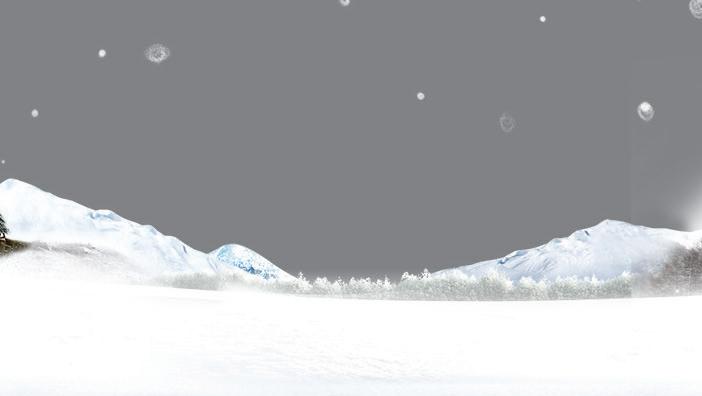









Agreed
Trickles
Uniform fabric
Make fit
Murmured softly
Spirit in a lamp
Al Unser, for one
Gauzy fabric

Keyed up
Inched
Love, in Italy
Physicist Nikola --

More blustery
Not hunched
State, in Paris
Shoulder gesture
Used a CB
Docket

Crowned heads
Piece of cake
Rent, as a limo
Rhapsodizes
Sleeping
“-- never fly”
Woe
Twangy
Autumn mo.
Musical notes
Like a seance
Fiberglass bundles
Virginia caverns
Wax theatrical
Be concerned
Cosmos
Femme fatale
Bleached out
Military student
Unceasingly
Passenger
Played charades
In action
Pitched in
Make -- -- buck
Lacking flavor
Weight deductions
Fiery stack
Wee parasite
Oversaw
Shade or tint

Hosiery brand

Fog or steam
Fixes a tooth
Ecol. police
Passed out
Just bought
Diogenes, for one
Major neighbor
Burn with steam
Minority groups
Frozen-faced
Della of song
More unusual
Pod veggie
Court ritual
Carol
Chart shape
Remove weeds


Comes closer
Explosive letters

Cousin of PDQ
Hook-and-loop fastener
-- -- rush 18 Deliberate a ronts 19 Video companion 20 Prolonged attack 30 In judge’s garb 32 Homeric epic 34 Took steps 40 Spanish article
All-purpose vehicles
Onward
Whiz
Fridge maker 80 Type of cake 81 Wrinkled fruit 82 Roused up 84 Huge-cast films 85 Sandy ridges 86 Blows away 87 Aim 88 Get-together 90 -- noire

MY SISTER was wearing a T-shirt with that message printed on the front when I was in New Mexico visiting in September. She wasn’t the only one.
Surprisingly, at least to me, the responses she got were largely positive. Other women asked where she got it and said they were going to get one when they got home. There were some nasty looks from other folks, but no negative comments.
While I was fully prepared to write at least half the population of my former
BY G.D. MAXWELLhome off for their embrace of the dark side and apparent lack of a moral compass, they surprised me last Tuesday—and in the days that followed—by renouncing the excesses and lingering smell of the Orangehaired Monster and voting as though they’d awakened from a somnambulant state of lapsed judgement and/or complacency.
The much-touted Red Wave proved to be more of a Red Ripple, albeit like the wine of the same name, both tasteless and consumed by those with no appreciation for just how lousy it is.
Across the country, people voted as though they had both brains and a conscience. Okay, still only about half the country, but at least the outcome was so much better than hoped for.
At last count, the Dems will hold their slim lead in the U.S. senate, and may increase it by one sentient being, depending on the outcome of a run-off election in Georgia early next month. On the ground, the current squeaker of a victory means the Republicants don’t have the power to overturn even the meagre victories of Joe Biden’s infrastructure bill and Inflation Reduction Act, both of which promise to do more in the fight against climate change than anything the Republicants are even thinking of doing.

Of course, Republicants are, for the moment, too busy deriding their former leader, claiming he’s responsible for turning what looked like a sweep of both houses of Congress into a stinking pile of dung. No sooner did the early poll surveys start to come in than former supporters began to assail The Don for poisoning the well. Nice to see... but four years too late.
The hypocrisy of leading Republicants is fully revealed. When The Don was a winning ticket, they were lining up to kiss his ring, or something else the editor would probably make me change but may well be more accurate. Now that he’s a liability, they’re fighting among themselves like a Black Friday mob at Walmart to push him off the plank and into the shark-infested waters swirling the Good Ship GOP.
I have no doubt if the Orange-haired Monster rises, phoenix-like, between now
and the 2024 election, they’ll line up once more, lips puckered. In the absence of any governing principles, winning is their everything.
And with his announcement on Tuesday, Nov. 15, the suspense is over—the Monster will roll the dice again and fire up the Make Trump Grate Again machine.
Whatever happens next, it’s at least gratifying to imagine the Monster fuming at the fact his old supporters—MAGAsites notwithstanding—are calling him a loser. Fox News is straining to reach escape velocity from their sycophantic support for him. A raft of Republicant presidential hopefuls are firing up their own campaigns, including the intolerable governor of Florida, who was once a Mini-Me Trump but is now referred to by his creator and derider as Ron DeSanctimonious. Leading elites of the party are cloistered in back rooms trying to figure out whether they can effectively keep Trump from the GOP ticket two years from now.
Meanwhile, federal and state prosecutors are tripping over themselves on the courthouse steps to file criminal legal cases against him and the various con games he’s run most of his life.
Which, pundits say, is one of the reasons he may bull ahead and launch his campaign: to forestall legal action. There isn’t a case where ex-presidents have had criminal charges brought against them, and in a country willing to give Richard Nixon a pass, it’s a short step to imagining they’d be loathe to indict a presidential candidate who used to be commander-in-chief. Too bad.
There seems to be no doubt overturning Roe sparked a renewed interest in fighting to regain and retain hard-won rights. The reality is the political hacks appointed to the Supreme Court who, one after another at their confirmation hearings, promised to uphold the precedent of Roe only to later act as though they’d had their fingers crossed
hopeless situation.

So, are there any lessons to be learned by Canada’s populist, right-wing nuts? I don’t delude myself into thinking there are too many Albertans, other than NDP supporters, who are losing sleep over the election of Danielle Smith and her crazy, kill-Canada ravings. There’s a good reason the province is referred to as Texas North. Must be something about oil and gas that affects the brain.
But certainly Pierre Pottymouth has to be thinking hard about the PhoneHome-ET planks in his platform. He’s been uncharacteristically quiet about his former plan to save Canada’s financial health by embracing cryptocurrency. I’d love to know how much of his own wealth he had tied up in that before it crashed and burned.
He’s aligned himself with New Brunswick’s premier, who has been embracing an assault on official bilingualism, a move likely to keep the Conservatives from making any inroads in Quebec, a vote-rich province that has been a wasteland for them since Brian Mulroney was prime minister.
when answering senators’ questions, reinvigorated the generation who fought initially for the right for women to choose— and awakened the subsequent generations who blithely believed the choices they’d inherited required no further defence from them.
Their mobilization, and the addition of “moderate” Republicants who still had a glimmer of a social conscience, breathed hope into what looked like a
There’s still a large part of the country who questions his sanity toadying up to the freedumb convoy protesters last winter in Ottawa. He’s tried to put some breathing space between his embrace of them and the current reality by suggesting he only supported, “peaceful and lawabiding protesters ... while condemning any individuals who broke laws, behaved badly or blocked infrastructure.” In other words, all of them?
At least politics is getting interesting again. Between the Monster and covid, I was losing interest. It’s kind of like getting an old friend back. ■




